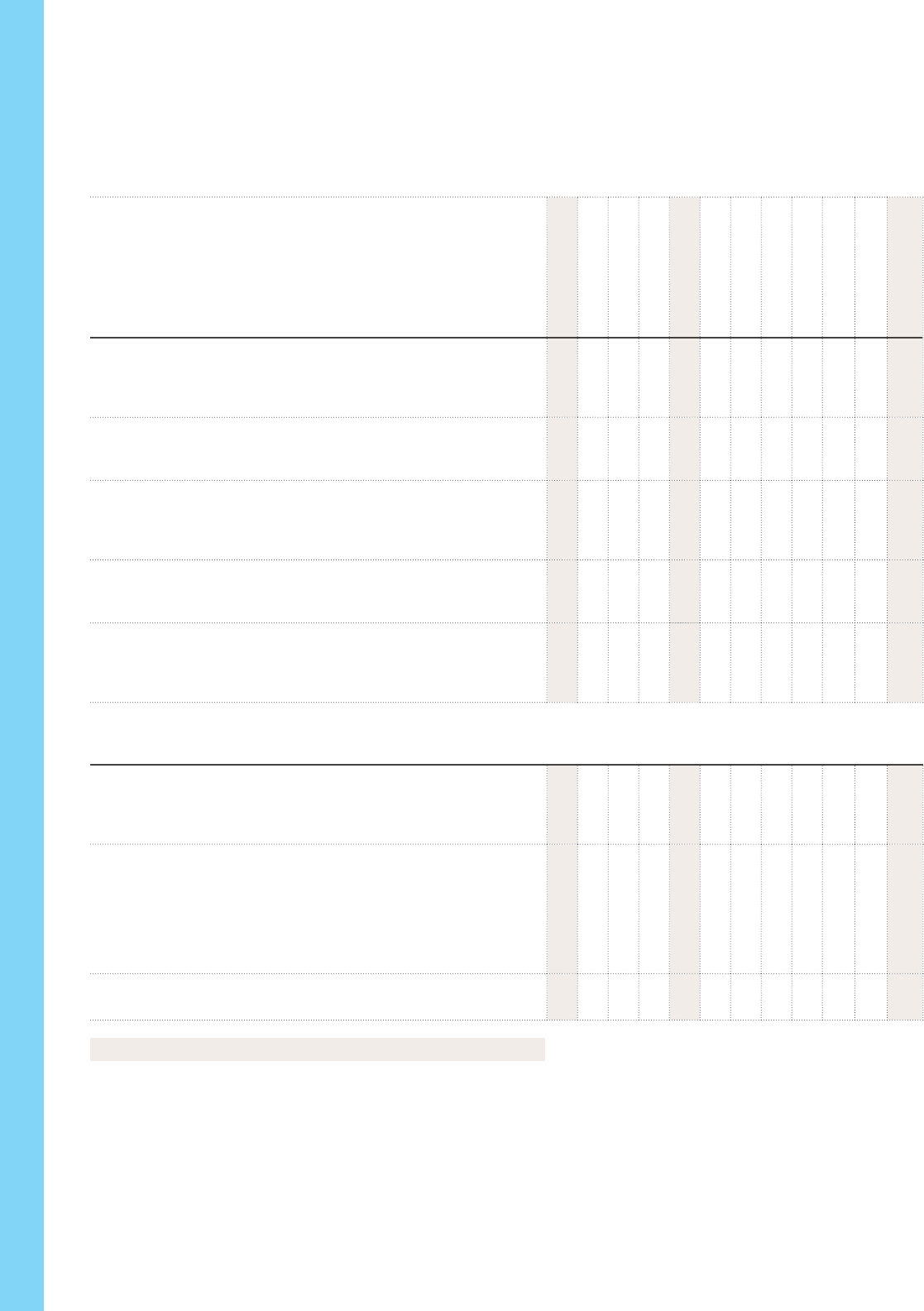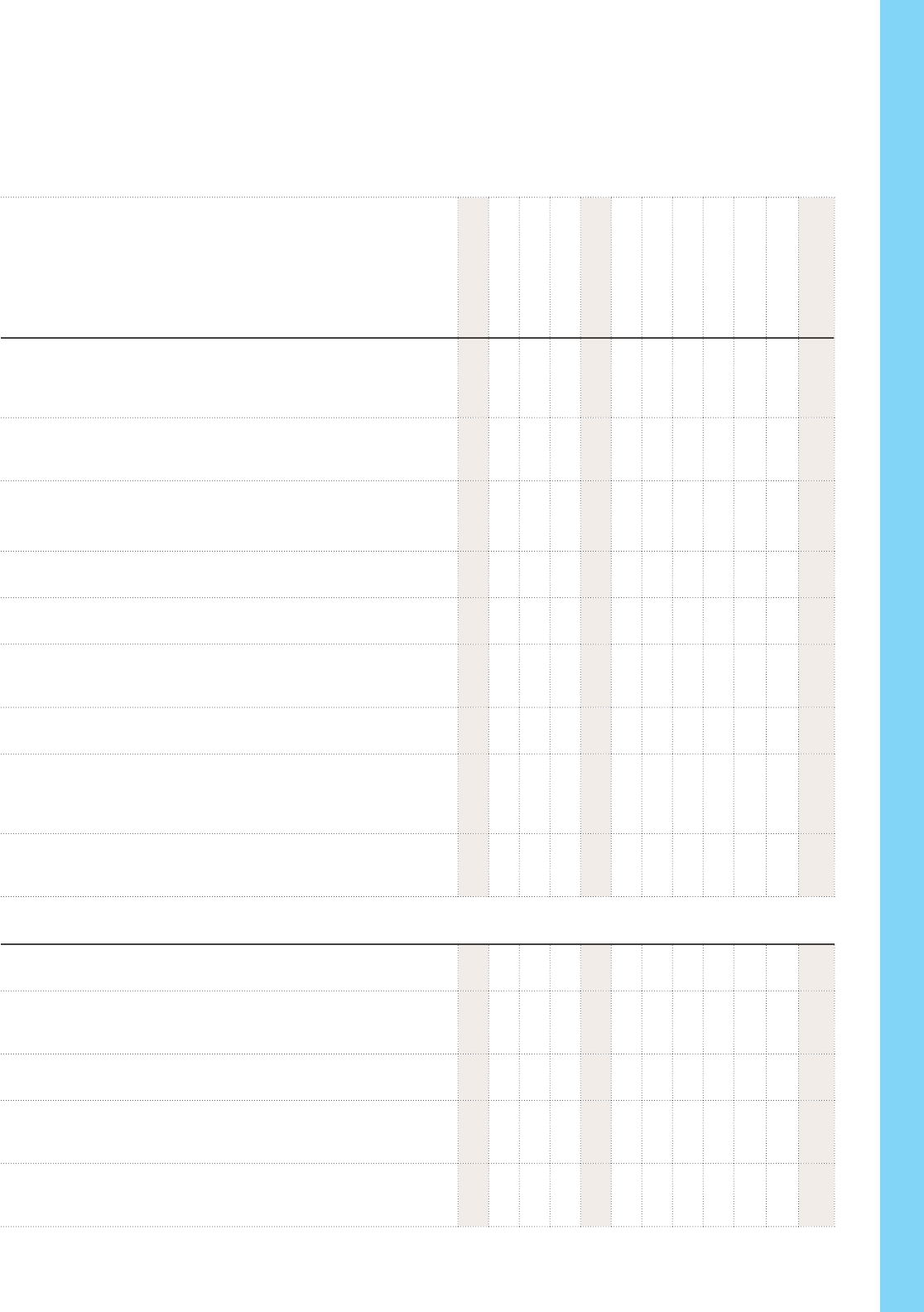
2024
A Complete Guide
to Your UC Health
and Welfare Benefits
MEDICAL, DENTAL, VISION, LIFE AND MORE

GETTING HELP
MEDICAL PLANS
CORE, UC Care, UC Health Savings Plan uchealthplans.com
• Accolade (Health Care Advocate): 866‑406‑1182
or member.accolade.com
• Anthem Blue Cross (Medical): anthem.com/ca
• Navitus Health Solutions (Pharmacy): 833‑837‑4308
Formulary: benetplans.navitus.com/university-of-california
Contact Accolade for all your health care questions. Anthem
processes claims and provides ID cards, and Navitus is phar‑
macy benet manager.
Health Savings Account (HealthEquity)
866‑212‑4729 learn.healthequity.com/uc/hsa
Kaiser HMO (Kaiser Permanente—California,
Optum Behavioral Health)
• Kaiser: 800‑324‑9208 select.kp.org/university-of-california
• Optum: 888‑440‑8225 liveandworkwell.com (access code:
11280)
UC Blue & Gold HMO (Health Net, MHN Behavioral Health)
• Health Net: 800‑539‑4072 healthnet.com/uc
• Health Net Behavioral Health: 800‑663‑9355
OTHER BENEFITS
Delta Dental PPO (Delta Dental)
800‑777‑5854 www1.deltadentalins.com/group-sites/uc.html
DeltaCare
®
USA Dental HMO (Delta Dental)
800‑422‑4234 www1.deltadentalins.com/group-sites/uc.html
VSP Vision Plan (VSP)
866‑240‑8344 vsp.com
Accident, Critical Illness, Hospital Indemnity, Life, Accidental
Death & Dismemberment (Prudential)
855‑483‑1438
Business Travel Accident
ucal.us/businesstravel
Disability—Basic, Voluntary Short-Term,
Voluntary Long-Term (Lincoln Financial)
800‑838‑4461 (claims) mylincolnportal.com
OTHER PLANS
Adoption Assistance Plan (WEX Health)
844‑561‑1338 ucal.us/adoptionassistance
Auto/Homeowner Farmers Insurance Choice
SM
866‑700‑3113
Family Care Resources (Bright Horizons Enhanced Family Supports)
888‑748‑2489 clients.brighthorizons.com/universityofcalifornia
Flexible Spending Accounts Health, Limited Purpose and
Dependent Care
(WEX Health)
844‑561‑1338 uc-fsa.com
Legal (ARAG)
800‑828‑1395 araglegal.com/ucinfo
Pet Insurance (Nationwide)
877‑738‑7874 petinsurance.com/uc
UC SYSTEMWIDE RESOURCES
UCnet
ucnet.universityofcalifornia.edu
UCPath
855‑982‑7284 ucpath.universityofcalifornia.edu
UC Retirement At Your Service (UCRAYS)
retirementatyourservice.ucop.edu
UC BENEFITS OFFICES
Agriculture & Natural
Resources
530‑752‑1774
Berkeley
510‑664‑9000, option 3
Davis
530‑752‑1774
Davis Health
916‑734‑8099
Irvine
949‑824‑0500
Irvine Health
949‑824‑0500
Los Angeles
310‑794‑0830
Los Angeles Health
310‑794‑0500
Merced
209‑355‑7178
Oce of the President
855‑982‑7284
Riverside
951‑827‑4766
San Diego
858‑534‑2816
San Diego Health
619‑543‑3200
San Francisco
415‑476‑1400
San Francisco Health
415‑353‑4545
Santa Barbara
805‑893‑2489
Santa Cruz
831‑459‑2013
Lawrence Berkeley
National Lab
510‑486‑6403
ASUCLA
310‑825‑7055
UC Law San Francisco
(formerly UC Hastings)
415‑565‑4703

Chapter Title
1
Welcome to the University of California!
As a University of California employee, you help shape the quality
of life for people throughout California and around the world.
Every faculty and sta member plays an important role in UC’s
mission of education, research and public service; UC’s high-quality,
comprehensive benets are among the rewards you receive in return.
These benets are an important part of your total compensation.
Our health and welfare benets program provides both choice and
value to meet the needs of our diverse workforce.
We know that making benets choices can be a bit overwhelming.
So we have tools and information to help you make the right choices
for you and your family.
This booklet oers a comprehensive overview of your health
and welfare benets options, including details about eligibility,
enrollment and the plans available to you. It also explains how
changes in your life and in your employment status can aect your
benets. Keep this booklet, and Your Benets at a Glance (included
in your Welcome Kit), for future reference.
UCnet (ucnet.universityofcalifornia.edu) oers additional tools and
information, along with ongoing updates about your benets. Visit
UCnet whenever you have questions about your benets or want to
make changes. You can also call your local Benets Oce or any of
the plans. You’ll nd their contact information on the insert at the
front of this booklet.
The information in this booklet reects the terms of the benet plans as in eect Jan. 1, 2024. Please note that this is a summary of your benets only; additional
requirements, limitations and exclusions may apply. Refer to applicable plan documents and regulations for details. The applicable policy issued by the carrier and the
University of California Group Insurance Regulations and other applicable UC policies will take precedence if there is a dierence between the provisions therein and those
of this document.
Welcome to UC

Chapter Title
2

Chapter Title
3
General Eligibility Rules for UC Health and
Welfare Benets
............................................................................................... 5
Enrollment
............................................................................................................ 16
Medical Plans
..................................................................................................... 19
Dental Plans
........................................................................................................ 24
Vision Plan
............................................................................................................ 28
Accident, Critical Illness and Hospital Indemnity
...................... 29
Disability Insurance
....................................................................................... 31
Basic and Voluntary Disability
.................................................................... 31
Life Insurance
..................................................................................................... 34
Basic and Core Life Insurance
..................................................................... 34
Supplemental Life Insurance
....................................................................... 35
Dependent Life Insurance
............................................................................. 37
Accidental Death and Dismemberment Insurance
.......................... 39
Business Travel Accident Insurance
......................................................... 41
Adoption Assistance Plan
.......................................................................... 42
Legal Insurance
................................................................................................. 43
Pet Insurance
...................................................................................................... 45
Family Care Resources
.................................................................................. 46
Flexible Spending Accounts
...................................................................... 47
Health Flexible Spending Account
........................................................... 47
Dependent Care Flexible Spending Account
...................................... 48
Legal Notices
...................................................................................................... 51
Participation Terms and Conditions
........................................................ 51
HIPAA Notication for Medical Program Eligibility
........................ 52
Notice Regarding Administration of Benets
..................................... 53
Table of Contents
Table of Contents

4

Chapter Title
5
General Eligibility Rules for UC Health and Welfare Benets
UC oers three benets packages for faculty and sta — Full,
Mid-Level and Core. Your eligibility for a particular benets
package depends on the type of job you have, the percentage of
time you work and the length of your appointment.
The eligibility requirements are listed below. See the chart on
pages 10 to 12 for a list of the benets available to you, based on
the level of benets for which you qualify.
REQUIREMENTS FOR EMPLOYEES IN CAREER,
ACADEMIC, LIMITED, PARTIAL-YEAR CAREER, CONTRACT
AND FLOATER APPOINTMENTS
FULL BENEFITS
You are eligible for Full Benets if you are an active UCRP
member, an active Savings Choice participant or have begun the
90-day election period during which you can choose between
Pension Choice and Savings Choice.
1
There are two ways to qualify for these primary retirement
benets:
• You are appointed to work in a retirement-eligible position at
least 50 percent time for a year or more
2
or
• You complete 1,000 hours in a retirement-eligible position
within a rolling 12-month period (750 hours in certain
instances
3
).
MID-LEVEL BENEFITS
You are eligible for Mid-Level Benets if:
• You are appointed to work 100 percent time for at least three
months but for less than one year or
• You are appointed to work at least 50 percent time for a year
or more in a position that does not qualify you for the primary
retirement benets noted above.
CORE BENEFITS
You are eligible for Core Benets if you are appointed to work at
least 43.75 percent time.
REQUIREMENTS FOR EMPLOYEES IN PER DIEM,
CASUAL/RESTRICTED (STUDENTS), BY AGREEMENT AND
SEASONAL APPOINTMENTS
CORE BENEFITS
You are eligible for Core Benets if you are appointed to work at
least 75 percent time for at least three months.
ELIGIBLE FAMILY MEMBERS
You may enroll one eligible adult family member in addition
to yourself. Your children are also eligible for enrollment as
outlined below.
ELIGIBLE ADULT
You may enroll your spouse or an eligible domestic partner.
4
No declaration form or documentation is needed to initially
enroll your domestic partner, but you will be asked to submit
documentation after enrollment (see “Supporting
Documentation” in Benets for Domestic Partners) to establish
ongoing eligibility for health and welfare benets. To be eligible
for health and welfare benets, your domestic partnership must
meet one of the following requirements:
• Registered with the State of California or other valid
jurisdiction OR
• Able to meet the requirements on page 13 for a partnership
that has not been registered, with appropriate supporting
documentation upon request
Please note: Enrolling your domestic partner in health benets
and successfully completing the eligibility verication process
will establish your partner as your survivor for UC Retirement
Plan benets, subject to additional eligibility requirements.
1
In a few specically dened situations, UC employees may be eligible to
participate in UC health and welfare benets while being enrolled in a non-UC
retirement plan. Eligible employees may have been covered by entities that were
acquired by the University and/or they may have opted to remain in a previous
public retirement plan at the time of UC employment.
2
Or your appointment form shows that your ending date is for funding purposes
only and that your employment is intended to continue for more than a year.
3
If you’re a member of the Non-Senate Instructional Unit, you qualify for
participation in the Retirement Choice Program after working 750 hours in an
eligible position within a 12-month period.
4
An adult dependent relative is not eligible for coverage in UC plans unless
enrolled prior to Dec. 31, 2003 and continuously eligible and enrolled since that
date. Also, remember: If your eligible adult dependent relative is still enrolled in
the plan, you cannot enroll your spouse or domestic partner. The eligible adult
may be enrolled only in the same plans as you. See the chart on page 10 for
more information on eligible plans.
General Eligibility Rules for UC Health and Welfare Benets

Chapter Title
6
General Eligibility Rules for UC Health and Welfare Benets
ELIGIBLE CHILD
You may enroll your eligible children up to age 26 in the same
plans as those in which you enroll. A disabled child may be
covered past age 26, if the disability is veried by the carrier or a
physician. You may also enroll your legal ward up to age 18 in the
same plan(s) as those in which you enroll. The Family Member
Eligibility chart on pages 13 and 14 gives the eligibility criteria
for children, stepchildren, grandchildren, disabled children and
legal wards. You may enroll your eligible domestic partner’s child
or grandchild, even if you do not enroll your partner.
In order to be eligible for UC-sponsored coverage, your
grandchild, step-grandchild, or legal ward (see Family Member
Eligibility chart) must be claimed as a tax dependent by you or
your spouse. Your eligible domestic partner’s grandchild must
be claimed as a tax dependent by you or your domestic partner.
Also eligible are children UC is legally required by administrative
or court order to provide with group health coverage.
Overage disabled children must be claimed as a tax dependent
by either you or your spouse/domestic partner. If overage
disabled children are not claimed as a dependent for income tax
purposes, the overage disabled child must be eligible for Social
Security income or Supplemental Security Income (SSI) as a
disabled person or work in supported employment which may
oset the Social Security or SSI.
Your children (or legal ward) are eligible for only the plans for
which you are eligible and in which you have enrolled (See
“Benets Overview,” pages 10–12).
Except as provided in the following paragraph, application for
coverage beyond age 26 due to disability must be made to the
plan 60 days prior to the date coverage is to end due to the
child reaching limiting age. If application is received within this
timeframe but the plan does not complete determination of the
child’s continuing eligibility by the date the child reaches the
plan’s upper age limit, the child will remain covered pending the
plan’s determination. The plan may periodically request proof
of continued disability, but not more than once a year after the
initial certication. Disabled children approved for continued
coverage are eligible to participate in university-sponsored
medical, dental, vision, accident, critical illness, hospital
indemnity, legal, dependent life and AD&D plans for faculty and
sta. If enrollment is transferred from one UC plan to another, a
new application for continued coverage is not required; however,
the new plan may require proof of continued disability, but not
more than once a year.
If you are a newly hired employee with a disabled child over age
26 or if you acquire a disabled child over age 26 (through
marriage, adoption or domestic partnership), you may also apply
for coverage for that child. The child’s disability must have begun
prior to the child turning age 26. Additionally, the child must have
had continuous group health coverage since age 26. The plan will
ask for proof of continued disability, but not more than once a
year after the initial certication.
TAX IMPLICATIONS OF ENROLLING A DOMESTIC PARTNER
In most cases, your domestic partner and your partner’s children
do not automatically qualify as your dependents under the
Internal Revenue Code (IRC). That means any UC contribution
toward their medical, dental and vision coverage will be
considered “imputed income” or taxable income for federal tax
purposes. This income is reected in your annual W-2 statement.
If your domestic partner and partner’s children or grandchildren
are your dependents as dened by the IRC, you are not subject
to imputed income on UC contributions toward health coverage
for these family members.
In order for your payroll records to accurately reect this tax
dependency, you’ll need to report it to UC. Indicate the tax
status of your partner and/or partner’s children on UCPath when
you enroll them in benets.
UC’s contribution for medical, dental and vision coverage is
not considered imputed income for California state income tax
purposes if you and your domestic partner have registered your
partnership with the state of California. Also, if your partner’s
child is considered your stepchild under state law, federal
imputed income will not apply to UC’s contribution toward the
child’s coverage.
If your domestic partner is covered as your family member and
the two of you marry, be sure to update your information in
UCPath so that imputed income and state taxes no longer apply.
OTHER ELIGIBILITY RULES AND INFORMATION
NO DUPLICATE COVERAGE
UC rules do not allow duplicate coverage. This means you may not
be covered in UC-sponsored plans as an employee and as an eligible
family member of a UC employee or retiree at the same time.
If you are covered as an eligible family member and then become
eligible for UC coverage yourself, you have two options:
• You can opt out of your own employee coverage and remain
covered as another employee’s or retiree’s family member or
• You can enroll in your own coverage; before you enroll,
though, you must make sure the UC employee or retiree
who has been covering you disenrolls you from his or her
UC-sponsored plan.
Family members of UC employees may not be enrolled in more
than one UC employee’s plan. For example, if spouses both work
for UC, their children cannot be covered by both parents.
General Eligibility Rules for UC Health and Welfare Benets

Chapter Title
7
If duplicate enrollment occurs, UC will cancel the plan with
later enrollment. UC and the plans reserve the right to collect
reimbursement for any duplicate premium payments due to the
duplicate enrollment.
ELIGIBILITY VERIFICATION
When you enroll anyone in a plan as a family member, you
must provide documentation specied by the University
verifying that the individual(s) you have enrolled meet the
eligibility requirements outlined above. The plan may also
require documentation verifying eligibility status. In addition,
the University and/or the plan reserve the right to periodically
request documentation to verify the continued eligibility of
enrolled family members.
UnifyHR, which administers the family member eligibility
verication process, will send you a packet of materials to help
you complete the verication process. If you fail to provide the
required documentation by the deadline specied in these
materials, your family member(s) will be disenrolled until
verication is provided (upon verication, re-enrollment is
prospective, not retroactive). Individuals who are not eligible
family members will be permanently disenrolled.
You also may be responsible for any UC-paid premiums due to
enrollment of ineligible individuals.
WHEN COVERAGE BEGINS
The following eective dates apply provided the appropriate
enrollment transaction (electronic or paper form) has been
completed within the applicable enrollment period.
• If you enroll during a Period of Initial Eligibility (PIE), coverage
for you and your family members is eective the date the PIE
starts.
• If you enroll during Open Enrollment, the eective date of
coverage is the date announced by the University. In most
cases, it is the Jan. 1 following Open Enrollment.
• If you complete a 90-day waiting period for medical coverage,
such coverage is eective on the 91st consecutive calendar
day after the date the enrollment form is received.
FAMILY MEMBERS
When you have a family status change, coverage begins on the
rst day you have a new family member — such as a spouse,
domestic partner, newborn or newly adopted child. However,
if you request to change to a dierent medical plan at the time
you add a new family member, coverage under the new plan is
eective the rst of the following month for all family members.
If you are already enrolled in adult plus child(ren) or family
coverage, you may add additional children, if eligible, at any time
after their PIE.
CONTINUING ELIGIBILITY
UC bases your ongoing eligibility for benets on your average
hours of service
5
over a 12‑month, standard measurement
period (SMP). UC’s SMP for monthly-paid employees is
Nov. 1–Oct. 31; for bi-weekly paid employees, the SMP includes
the pay periods inclusive of those same dates (for example, in
2024, it runs from Nov. 6, 2023, until Nov. 5, 2024).
If your hours during the SMP meet the threshold to be oered
coverage, then that coverage must be oered, and if accepted,
will be provided during the subsequent stability period,
regardless of your number of hours during the stability period
(as long as you remain employed). UC’s standard stability period
for all employees is Jan. 1–Dec. 31.
If your hours during the SMP do not meet the threshold, then all
coverage ends on Dec. 31.
The required average hours of service threshold is:
Appointment Type Average Hours Threshold
Career, Academic, Limited, Partial-Year
Career, Contract, Floater
17.5 hours per week
Per Diem, Casual/Restricted (students),
By Agreement or other at-dollar
payments, Seasonal
30 hours per week
General Eligibility Rules for UC Health and Welfare Benets
5
Dened as all hours on pay status (including hours on call, hours on paid
vacation, paid holiday, paid sick leave, paid sabbatical, paid jury duty, or any
other paid leave) as well as hours on unpaid leave protected by the federal
Family & Medical Leave Act, unpaid jury duty, and unpaid leave protected by the
Uniformed Services Employment & Reemployment Rights Act. May also include
up to 501 hours during the SMP due to “employment break periods” of at least
4 consecutive weeks (e.g., academic breaks, etc.).

8
General Eligibility Rules for UC Health and Welfare Benets
General Eligibility Rules for UC Health and Welfare Benets
WHEN COVERAGE ENDS
The termination of coverage provisions established by the
University are summarized below.
DISENROLLMENT DUE TO LOSS OF ELIGIBLE STATUS
If you are an employee and lose eligibility, your coverage and
that of any enrolled family members ends at the end of the
month in which eligible status is lost. See pages 48-49 for rules
pertaining to Flexible Spending Accounts.
OTHER DISENROLLMENTS
If you are enrolled in a health and welfare plan that requires
premium payments, and you do not continue payment, your
coverage will be terminated at the end of the last month for
which you paid.
You and/or your family members may be disenrolled if you and/
or a family member misuse the plan, as described in the Group
Insurance Regulations. Misuse includes, but is not limited to,
actions such as falsifying enrollment or claims information;
allowing others to use the plan identication card; intentionally
enrolling, or failing to disenroll, individuals who are not/no longer
eligible family members; threats or abusive behavior toward plan
providers or representatives.
LEAVE OF ABSENCE, LAYOFF, CHANGE IN EMPLOYMENT
STATUS OR RETIREMENT
Coverage may end when you go on unpaid leave or leave UC
employment. For information about continuing your coverage
in the event of an authorized leave of absence, layo, change
of employment status or retirement, contact the person who
handles benets for your location.
FAMILY CHANGES THAT RESULT IN LOSS OF COVERAGE
If your family member loses eligibility, you must complete the
appropriate transaction to remove him or her from coverage
within 31 days of the eligibility loss event.
Divorce, legal separation, termination of domestic
partnership, annulment. Eligibility for your spouse or domestic
partner and any children for whom you are not the legal parent/
guardian ends on the last day of the month in which the event
occurs. Your legally separated spouse, former spouse or former
domestic partner and the former partner’s child or grandchild
may continue certain coverage under COBRA (Consolidated
Omnibus Budget Reconciliation Act of 1985) or they may
seek individual coverage, including through the health care
marketplace (coveredca.com). If a settlement agreement
between you and your legally separated/former spouse or
domestic partner requires you to provide coverage, you must do
so on your own.
An eligible child turning age 26. Unless a child is eligible to
continue coverage because of disability, coverage ends at the
end of the month in which the child reaches age 26. This rule
applies to your biological and adopted children, stepchildren,
grandchildren, step-grandchildren and your domestic partner’s
children or grandchildren. Certain coverage may be continued
under COBRA or they may seek individual coverage, including
through the health care marketplace (coveredca.com).
A legal ward turning age 18. Eligibility ends at the end of
the month in which the legal ward turns 18. Your legal ward
may continue certain coverage under COBRA or they may
seek individual coverage, including through the health care
marketplace (coveredca.com).
Death of a family member. Coverage for the family member
ends the last day of the month in which the death occurs. It
is important to contact your local Benets Oce for further
assistance in the event of an enrolled family member’s death.
CONTRACT TERMINATION
Health and welfare benets coverage is terminated when the group
contract between the University and the plan vendor is terminated.
Benets will cease to be provided as specied in the contract and
you may have to pay for the cost of those benets incurred after
the contract terminates. You may be entitled to continued benets
under terms described in the plan evidence of coverage booklet. (If
you apply for an individual conversion plan, the benets may not
be the same as you had under the original plans.)
OPPORTUNITIES FOR CONTINUATION
If you separate from UC employment, generally, your
UC-sponsored benets will stop. If you retire from UC, see
the Group Insurance Eligibility Fact Sheet for Retirees and Eligible
Family Members (available on the UCnet website at
ucnet.universityofcalifornia.edu/forms/pdf/group-insurance-
eligibility-factsheet-for-retirees.pdf) for more details.
COBRA (Consolidated Omnibus Budget Reconciliation Act
of 1985): If you or any family member(s) lose eligibility for
UC-sponsored medical, dental and/or vision coverage, you may
be able to continue group coverage through COBRA.
If you are enrolled in the Health Flexible Spending Account (FSA)
and you leave UC employment during the plan year, you may be
able to continue your participation under COBRA through the
end of the current plan year (Dec. 31) by making direct, after-tax
payments to your account.
If you lose eligibility, the COBRA administrator will send you a
“Qualifying Event Notice,” which explains the procedure for
continuing your participation. If your family member loses
eligibility, you must request a COBRA package through UCPath.
More information about COBRA continuation privileges is
available online at ucal.us/COBRA or from your Benets Oce.

9
General Eligibility Rules for UC Health and Welfare Benets
Conversion/Portability: Within 31 days after UC-sponsored
coverage ends (if your participation has been continuous), you
may be able to convert your group coverage to individual
policies or continue (“port”) your group coverage. See the
specic plan sections which follow for details.
Also, you may wish to contact the California Department of
Managed Health Care at dmhc.ca.gov
or 888‑466‑2219 to
determine whether you are eligible for HIPAA Guaranteed Issue
individual plan coverage or Covered California, California’s health
insurance marketplace, at coveredca.com
or 800‑300‑1506 to
review options for purchasing individual plan coverage.
ELIGIBILITY FOR STATE PREMIUM ASSISTANCE
If you are eligible for health coverage from UC, but cannot aord
the premiums, some states have premium assistance programs
that can help pay for coverage from their Medicaid or Children’s
Health Insurance Program (CHIP) funds.
If you live in California, you can contact the California Medicaid
(Medi-Cal) oce for further information via email (HIPP@dhcs.
ca.gov) or visit their website (dhcs.ca.gov). If you live outside
California, go online to ucal.us/chipra for a list of states that
currently provide premium assistance. You can also contact the
U.S. Department of Health and Human Services, Centers for
Medicare & Medicaid Services at cms.hhs.gov
; 877-267-2323.
FOR MORE INFORMATION
• Participation Terms and Conditions on page 51
• Benets for Domestic Partners
• Your local benets oce

10
Benets Overview
Benets Overview
HEALTH CARE
Benets Packages
Full
Mid‑Level
Core
When You May Enroll
During PIE
During OE
90‑Day Wait¹
Automatic
With SOH²
Anytime
Premium Paid By
Medical³
Choice of various options depending on your address, including health
maintenance organization (HMO), preferred provider organization (PPO) or
a PPO with a health savings account. See page 19.
• • • • •
You
and
UC
Medical — CORE
Fee-for-service plan with no employee premium and a $3,000 individual
deductible. See page 19.
• • • • • •
UC
Dental³
Choice of two plans: Delta Dental PPO, a fee-for-service plan, or DeltaCare® USA,
a dental HMO (network available in California only). Both cover preventive, basic
and prosthetic dentistry, as well as orthodontics. See page 24.
• • •
UC
Vision³
Plan covers a variety of vision care services including eye exams, corrective lenses
and frames. See page 28.
• • •
UC
Accident, Critical Illness and Hospital Indemnity
These plans are designed to complement medical and disability benets, but
are not a replacement for them. Plans pay cash benets directly to you if you
experience a covered accident, illness or hospital stay.
• • • • •
You
DISABILITY INSURANCE
Basic Disability
4
Provides basic coverage when unable to work due to pregnancy/childbirth or due to
a disabling injury or illness not related to work. Pays 55% of eligible earnings for up
to six months ($800 monthly maximum), after a waiting period. See page 31.
• • • •
UC
Voluntary Short-Term
4
and/or Voluntary Long-Term Disability
5
Provides short-term and/or long-term coverage for disabilities that are not related
to work, such as pregnancy/childbirth, injury or illness. Supplements employer-paid
Basic Disability and other sources of disability income you may receive (e.g.,
Workers’ Compensation or Social Security), up to 60% of eligible earnings ($15,000
maximum monthly benet). Enroll in Voluntary Short-Term Disability, Voluntary
Long-Term Disability or both. See page 31.
• • • • •
You
Workers’ Compensation
Provides state-mandated coverage for work-related injuries.
• • • •
UC
PIE: Period of Initial Eligibility OE: Open Enrollment SOH: Statement of Health
1
The 90-day waiting period is available when the PIE is missed. See page 19. You
may need to pay part of your premiums on an after-tax basis.
2
If you do not enroll during the PIE, you may apply for coverage by submitting an
evidence of insurability/statement of health. The carrier may or may not approve
your enrollment based on medical information in your application.
3
When you enroll in any UC-sponsored medical, dental or vision plan, you will not
be excluded from enrollment based on your health, nor will your premium or level
of benets be based on any genetic information or pre-existing health conditions.
The same applies to your eligible family members.
4
Employees are not covered under California State Disability Insurance for period
of employment at UC.
5
If you have a pre-existing condition which causes you to be disabled in your rst
year of coverage, your Voluntary Long-Term Disability benets will not be payable.
For more information, see the insurance carrier’s summary plan description and
Your Guide to UC Disability Benets.

11
Benets Overview
LIFE AND ACCIDENT INSURANCE
Benets Packages
Full
Mid‑Level
Core
When You May Enroll
During PIE
During OE
90‑Day Wait
Automatic
With SOH
Anytime
Premium Paid By
Basic Life
Provides employees eligible for Full Benets with life insurance equal to annual
base salary, up to $50,000. Coverage is adjusted if appointment is less than
100% time. See page 34.
• •
UC
Core Life
Provides employees eligible for Core or Mid-Level Benets with $5,000 of life
insurance. See page 34.
• • •
UC
Supplemental Life
Provides employees with additional life insurance at group rates. Coverage up to
four times annual salary (to $1,000,000 maximum). See page 35.
• • • •
You
Basic Dependent Life (Spouse/Domestic Partner)
Provides $5,000 of coverage. See page 37.
• • • •
You
Basic Dependent Life (Child/ren)
Provides $5,000 for each child. See page 37.
• • • •
You
Expanded Dependent Life (Spouse/Domestic Partner)
Coverage for 50% (up to $200,000) of employee’s Supplemental Life amount.
See page 37.
• • • •
You
Expanded Dependent Life (Child/ren)
Covers each child for $10,000. See page 37.
• • • •
You
Accidental Death & Dismemberment (AD&D)
You may enroll at any time. Provides up to $500,000 protection for employee and
family for accidental death, loss of limb, sight, speech or hearing, or for complete
and irreversible paralysis. See page 39.
• • • • •
You
Business Travel Accident
Provides up to $500,000 of coverage when an employee travels on ocial UC
business. See page 41 for enrollment instructions.
• • •
UC
OTHER BENEFITS
Adoption Assistance
No enrollment is required; see page 42.
• • • •
UC
Legal
Provides basic legal assistance for consultation/representation, domestic, consumer
and limited defensive legal services and identity theft benets. See page 43.
• • • • •
You
Pet Insurance
You may enroll at any time; see page 45.
• • • •
You
Automobile and Homeowner
You may enroll at any time, subject to underwriting approval from the insurer.
Call 866-700-3113 for details.
• • • •
You
Family Care Resources
Provides access to prescreened caregivers, pet sitters, tutors and other family
services. You may enroll at any time; see page 46.
• • • •
You

Chapter Title
12
Benets Overview
TAX-SAVINGS PROGRAMS
Benets Packages
Full
Mid‑Level
Core
When You May Enroll
During PIE
During OE
90‑Day Wait
Automatic
With SOH
Anytime
Pretax Salary Reduction
General Purpose Health Flexible Spending Account (Health FSA)
Lowers taxable income by allowing payment for up to $3,050 of eligible out-of-
pocket health care expenses on a pretax basis. Can be paired with any UC medical
plan other than UC Health Savings Plan. See page 47.
• • • • • •
Dependent Care Flexible Spending Account (DepCare FSA)
Lowers taxable income by allowing payment for up to $5,000 (or $3,000 if considered
a “highly compensated employee” by the IRS; $2,500 if married and ling a separate
income tax return) of eligible dependent care expenses on a pretax basis. See
page 48.
• • • • • •
Health Savings Account (HSA) — Paired with UC Health Savings Plan
You and UC contribute to the HSA, up to the limits set each year by the IRS — for
2024, this limit is $4,150 for individual coverage and $8,300 for family coverage.
People age 55 and over can make an additional “catch-up” contribution of $1,000.
Can only be paired with UC Health Savings Plan. See page 47.
• • • • •
PIE: Period of Initial Eligibility OE: Open Enrollment SOH: Statement of Health
Benets Overview

Chapter Title
13
Benets Overview
ELIGIBLE FAMILY MEMBERS
Eligibility
May enroll in
Medical
Dental
Vision
Accident, Critical Illness
and Hospital Indemnity
Dependent Life
AD&D
Legal
Legal Spouse
1
Eligible
• • • • • • •
Domestic Partner
A domestic partnership is eligible if it is:
• Registered with the state of California or
• A valid union, other than a marriage, entered into in another jurisdiction and recognized
in California as substantially equivalent to a California registered domestic partnership or
• Unregistered, but meets all of the following criteria:
– Parties must be each other’s sole domestic partner in a long-term, committed
relationship and must intend to remain so indenitely
– Neither party may be legally married or be a partner in another domestic partnership
– Parties must not be related to each other by blood to a degree that would prohibit legal
marriage in the State of California
– Both parties must be at least 18 years old and capable of consenting to the relationship
– Both parties must be nancially interdependent
– Parties must share a common residence
Eligible
• • • • • • •
Biological or adopted child, stepchild, domestic partner’s child
2
To age 26
• • • • • • •
Grandchild, step-grandchild, domestic partner’s grandchild
2
• Unmarried
• Living with you
• Supported by you or your spouse/domestic partner (50% or more)
• Claimed as a tax dependent by you or your spouse/domestic partner
To age 26
• • • • • • •
Legal ward
• Unmarried
• Living with you
• Supported by you or your spouse/domestic partner (50% or more)
• Claimed as your tax dependent
• Court-ordered guardianship required
To age 18
• • • • • • •
1
A legally separated or divorced spouse is not eligible for UC-sponsored coverage.
2
Domestic partner must be eligible for UC-sponsored health coverage.

Chapter Title
14
ELIGIBLE FAMILY MEMBERS
Eligibility
May enroll in
Medical
Dental
Vision
Accident, Critical Illness
and Hospital Indemnity
Dependent Life
AD&D
Legal
Overage disabled child (except a legal ward) of employee
• Unmarried
• Incapable of self-support due to a mental or physical disability incurred prior to age 26
• Enrolled in a UC group medical plan before age 26 and coverage is continuous; if eligible
for enrollment in a UC plan after age 26 (during your PIE, qualifying life event or Open
Enrollment, or if you newly acquire a disabled child over age 26), the child must have had
continuous coverage since age 26
• Chiey dependent upon you, your spouse or eligible domestic partner for support (50%
or more)
• Claimed as your, your spouse’s or your eligible domestic partner’s dependent for income
tax purposes or eligible for Social Security income or Supplemental Security Income as a
disabled person. The overage disabled child may be working in supported employment
that may oset the Social Security or Supplemental Security Income
• Must be approved by the carrier before age 26 or by the carrier upon initial enrollment
Age 26
or older
• • • • • • •
Benets Overview
Benets Overview

Chapter Title
15

16
Enrollment
Enrollment
To be certain you get the benets coverage you want, you should
enroll yourself and your eligible family members when you rst
become eligible.
For step‑by‑step instructions on how to enroll, see Your
Benets at a Glance, which you received in your Welcome Kit.
WHEN TO ENROLL
DURING A PERIOD OF INITIAL ELIGIBILITY (PIE)
A PIE is a time during which you may enroll yourself and/or your
eligible family members in UC-sponsored health and welfare
plans. A PIE generally starts on the rst day of eligibility — for
example, the day you are hired into a position that makes you
eligible for benets. It ends 31 days later.
You should enroll online and complete the transaction by the
last day of the applicable PIE. Paper enrollment forms are
available and need to be received at the location noted on the
form by the last day of the applicable PIE. (If the last day falls
on a weekend or holiday, the PIE is extended to the following
work day.)
You may enroll your eligible family members during the 31-day
PIE that begins on the rst day the family member meets all
eligibility requirements. If your enrollment is completed during
your PIE, coverage is eective the date the PIE began.
The PIE to enroll newly eligible family members starts the day
your family member becomes eligible:
• For a spouse, on the date of marriage.
• For a domestic partner, on the date the domestic partnership
is registered or the date that you verify that the partnership
meets UC’s criteria (see page 13).
• For a newborn child, on the child’s date of birth
• For an adopted child, the earlier of:
– the date the child is placed for adoption with you, or
– the date you or your spouse/domestic partner has the legal
right to control the child’s health care.
A child is “placed for adoption” as of the date you assume and
retain a legal obligation for the child’s total or partial support
in anticipation of the child’s adoption.
If the child is not enrolled during the PIE beginning on that
date, there is an additional PIE beginning on the date the
adoption becomes nal.
• For a legal ward, the eective date of the legal guardianship.
Where there is more than one eligibility requirement, the PIE
begins on the date all requirements are satised.
During this family member PIE, some plans allow you to also
enroll yourself and/or any other eligible family member who was
not already enrolled during an earlier PIE. See the plan-specic
sections at the back of this booklet. Remember that family
members are only eligible for coverage in medical, dental, vision,
accident, critical illness and hospital indemnity, legal, AD&D and
dependent life coverage and must be enrolled in the same plans
in which you are enrolled.
OTHER ENROLLMENT OPPORTUNITIES
If you don’t enroll in benets during your initial 31-day period
of eligibility, you may be able to enroll yourself and your family
members in some plans at other times, including:
OPEN ENROLLMENT
Usually held in the fall, Open Enrollment is your annual
opportunity to make changes to your benets, including:
• Transferring to a dierent medical or dental plan
• Adding or disenrolling eligible family members
• Enrolling in or opting out of UC-sponsored medical, dental,
vision, accident, critical illness, hospital indemnity and legal
plans
• Enrolling or re-enrolling in the Health and Dependent Care
Flexible Spending Accounts
Changes made during Open Enrollment are eective Jan. 1 of
the following year. Not all plans are available during every Open
Enrollment.
Meet ALEX!
Choosing benets doesn’t have to be complicated. ALEX is a
condential online tool that helps you select the best benets
for you and your family.
Tell ALEX a little about yourself and get personalized guidance
for making the most of your UC benets.
start.myalex.com/uc

17
Enrollment
WHEN YOU HAVE A FAMILY CHANGE
When you have a new family member, such as a spouse, domestic
partner, newborn or newly adopted child, you may enroll yourself,
the new family member and any other eligible family members not
already enrolled in your UC-sponsored health plans. Other plans
have dierent rules; see the plan-specic sections in this guide
for details.
If you are enrolled in a UC-sponsored medical plan, you may
transfer to a dierent plan. (This change to a new medical plan
will go into eect the rst day of the following month.) You
may also enroll in or increase your Legal insurance, Accident,
Critical Illness and Hospital Indemnity insurance, Supplemental
Life insurance and Dependent Life insurance during this
eligibility period (however, restrictions apply to Dependent Life
insurance). There is no opportunity to enroll in Voluntary
Short-Term or Voluntary Long-Term Disability insurance.
You have 31 days from the date your new family member becomes
eligible to enroll the new member or to make any permitted plan
changes (for example, 31 days from the day you marry or your
child is born). You must enroll family members in your UCPath
account; enrollment is not automatic.
You will be required to complete the Family Member Eligibility
Verication process after enrolling the new family member. If
you do not respond by the given deadline, your new family
member may be disenrolled from the plans.
WHEN YOU LOSE OTHER COVERAGE
If you decline UC-sponsored coverage because you and/or your
family members are covered elsewhere, and you later lose the
other coverage, you may be eligible to enroll yourself and/or
your eligible family members in a UC-sponsored plan. The same
is true if you are enrolled in another employer-sponsored plan
and the employer stops contributing to the cost of the coverage.
For medical, dental and vision coverage, you may enroll without
waiting for the University’s next open enrollment period if you
have met all of the following requirements:
• You were covered under another health plan as an individual
or dependent, including coverage under COBRA or CalCOBRA
(or similar program in another state), the Children’s Health
Insurance Program or “CHIP” (called the Healthy Families
Program in California), or Medicaid (called Medi-Cal in
California).
• Coverage under another health plan for you and/or your
eligible family members ended because you/they lost
eligibility under the other plan or employer contributions
toward coverage under the other plan terminated, coverage
under COBRA or CalCOBRA continuation was exhausted, or
coverage under CHIP or Medicaid was lost because you/they
were no longer eligible for those programs.
• You properly le an enrollment form with the University
during the 31-day PIE which starts on the day after the other
coverage ends. Note that if you lose coverage under CHIP or
Medicaid, your PIE is 60 days. You may need to provide proof
of loss of coverage.
OTHER SPECIAL CIRCUMSTANCES
For medical, dental and vision coverage, you may enroll without
waiting for the University’s next open enrollment period if you
are otherwise eligible under any one of the circumstances below:
• You or your eligible family members are not currently enrolled
in UC-sponsored medical, dental or vision coverage and you
or your eligible family members become eligible for premium
assistance under the Medi‑Cal Health Insurance Premium
Payment (HIPP) Program or a Medicaid or CHIP premium
assistance program in another state. Your PIE is 60 days from
the date you are determined eligible for premium assistance.
If the last day of the PIE falls on a weekend or holiday, the PIE
is extended to the following work day if you are enrolling with
paper forms.
• A court has ordered the University of California to provide
coverage for a dependent child under your UC-sponsored
medical, dental or vision plan pursuant to applicable law. The
child must meet UC eligibility requirements.
IF YOU ARE A NEW FACULTY MEMBER
Newly appointed faculty members who don’t enroll within 31 days
of their start date have a second period of eligibility that begins
on the rst day of classes for the semester or quarter in which the
appointment starts or the rst day the faculty member arrives at
the campus, whichever comes rst.
Appeals
Any appeals regarding coverage denials that relate to
eligibility or enrollment requirements are subject to the
University of California Group Insurance Regulations. To
obtain a copy of the Eligibility Claims Appeal Process, please
contact the person who handles benets for your location or
visit UCnet.

Chapter Title
18

Chapter Title
19
Medical Plans
Benets packages: Full, Mid‑Level, Core
Who’s covered: You and your eligible family members
Who pays the premium: You and UC, for most plans
Medical coverage is one of the most important benets that
UC oers you and your eligible family members, and UC makes
medical coverage as accessible and aordable as possible.
UC oers a range of high-quality medical plans with
comprehensive coverage so you can choose the coverage that
best meets your needs.
You should carefully evaluate your family circumstances and plan
costs before selecting medical plan coverage. If you need more
information about a specic medical plan, you’ll nd telephone
numbers and links to all the plans’ websites on the inside cover of
this guide.
In addition to the general eligibility rules beginning on page 5
and plan eligibility rules found in each plan’s evidence of
coverage booklet, the following rules and information apply to
UC medical plans.
ELIGIBILITY
The medical plans you’re eligible for are based on whether your
overall benets package is Full, Mid-Level or Core.
If you are eligible for coverage, you must take action to enroll.
You may enroll in certain medical plans only if you meet the
plan’s geographic service area criteria.
If you or a covered family member is enrolled in Medicare,
you are not eligible for the UC Health Savings Plan due to IRS
rules that do not allow Medicare members to make or receive
contributions to a Health Savings Account.
WITH A 90-DAY WAITING PERIOD
If you miss your initial enrollment period, you may enroll yourself
and/or your family members in medical coverage at any time by
submitting an enrollment form to your Benets Oce. Your
medical coverage will become eective 90 calendar days from
the date your form is received. Your premiums will be paid on an
after-tax basis until the following Jan. 1.
IF YOU MOVE OUT OF A PLAN’S SERVICE AREA
If you move out of a plan service area, or will be away for more
than two months, you and your eligible family members must
transfer into a dierent plan available in your new location. If
you later return to your original location, you will have a Period
of Initial Eligibility during which you can re-enroll in your original
plan if you choose.
TRANSITIONING TO MEDICARE
If you continue working at UC past age 65 and you have a UC-
sponsored employee medical plan, you are not required to sign
up for Medicare Parts A, B or D. Any family member covered by
your employee plan, with the exception of your domestic partner
in some cases, who becomes eligible for Medicare may also defer
signing up for Medicare.
If you and/or any covered family members lose eligibility for
the UC-sponsored employee plan, you and/or your Medicare-
eligible family members should immediately enroll in Medicare or
another employer group health plan to avoid any penalties from
the Centers for Medicare and Medicaid Services (CMS).
If you plan to retire in 2024 and take a monthly retirement
benet, are eligible for retiree health insurance and expect to
enroll in Medicare during the year, think carefully about the UC
medical plan you choose. The choice you make will aect which
Medicare plan you’re transferred into when you turn 65. See
ucal.us/medicare for more information.
WHAT THE PLANS COVER
UC’s medical plans provide comprehensive coverage, including
doctor visits, hospital services, prescription drugs and behavioral
health services. Preventive care such as physical exams and
immunizations are free of charge in all plans; some restrictions,
such as using in-network providers, may apply.
There are no exclusions for pre-existing conditions.
An overview of the plans UC oers is on pages 20 to 22. The
chart on page 23 provides a comparison of the plans. Only UC
Health Savings Plan is compatible with a health savings account
(HSA). Other UC medical plans can be paired with UC’s Health
Flexible Spending Account (FSA). See page 47 to learn more.
COST OF COVERAGE
Your medical plan’s monthly cost depends on:
• The plan you choose
• Whether you choose to cover yourself only or yourself and
other family members and
• Your annual full-time equivalent salary from UC
Premium costs are available online at ucal.us/medicalpremiums
and in Which Medical Plan is Right for You? included in your
Welcome Kit.If you enroll in a medical plan that requires you to
pay a premium, your premium is deducted from your paycheck
each month before taxes are calculated.
Medical Plans

Chapter Title
20
Medical Plans
Please note: Premium rates for certain employee groups may
vary from those posted or printed. If you are represented by a
union, your premiums are subject to collective bargaining. To
conrm your premiums, sign in to your online benets account
or talk to your Benets Oce.
HEALTH MAINTENANCE ORGANIZATIONS (HMO)
HMOs require you to choose a primary care physician (PCP) from
their network of providers to coordinate your care. To see a
specialist, you must have a referral from your PCP. The HMO
covers your expenses only if your PCP has authorized the services,
unless it’s an emergency. You pay a copayment for some products
and services, and there is no annual deductible.
You must live (or work, depending on the plan’s rules) in the
plan’s service area to be eligible. Service areas are established
by ZIP codes; you cannot use a P.O. box to establish eligibility.
If you want to know whether your ZIP code is in a plan’s service
area, check the plan’s website or call the plan directly.
UC’s HMOs are available only if you and your covered family
members live and work in certain counties in California.
Health Net is the administrator of medical, behavioral health
and pharmacy benets for UC Blue & Gold HMO. Kaiser
Permanente — CA is the administrator of medical, behavioral
health and pharmacy benets for Kaiser HMO. The
administrator of your plan processes claims, creates a network of
health care providers and pharmacies and sets clinical policies
and guidelines.
UC’S HMO PLANS
UC Blue & Gold HMO Oers a tailored network of medical groups, doctors and hospitals, and includes all of UC’s medical centers
and medical groups. For more information, see healthnet.com/uc.
Kaiser HMO Oers a closed network, meaning you must use only Kaiser doctors and hospitals. For more information, see
select.kp.org/university-of-california.
Medical Plans
PREFERRED PROVIDER ORGANIZATIONS (PPO)
PPOs oer a broad network of providers and allow you the
exibility to see non-network providers if you wish. You don’t
need a referral to see specialists. Usually, you must meet the
plan’s deductible and then you pay coinsurance, which is a
percentage of the cost of services. You pay a smaller percentage
for in-network providers.
Anthem Blue Cross is the administrator of medical and
behavioral health benets for UC’s PPO plans, and Navitus
Health Solutions (Navitus) is the administrator of prescription
drug benets.
Contact Accolade Health Care Advocate for all member services,
including benets and coverage questions.
UC’s PPOs are the best option if you or your covered family
members live outside California.
UC’S PPO PLANS
UC Health Savings Plan with
Health Savings Account
This is the only UC medical plan paired with a Health Savings Account (HSA), which you can use to pay your
eligible medical expenses. UC contributes to the HSA every year you are enrolled in the plan, and you can,
too — federal tax-free. You pay the cost of medical services until you meet the deductible, then you pay a
percentage of the cost of services, with lower costs when you use in-network providers. Your unused HSA
funds roll over each year (funds are not use-it-or-lose-it). And, any funds you or UC contributes to your HSA
are yours to keep, even if you leave UC. You can continue to contribute to your HSA as long as you are
enrolled in a qualifying high deductible health plan. For more information, see uchealthplans.com and
learn.healthequity.com/uc/hsa
UC Care
This is a PPO plan with three tiers of doctors and hospitals. If you use providers in the UC Select Network,
which includes UC medical center doctors, hospitals and other facilities as well as select providers near UC
locations without a medical center, you pay copayments for services. If you use other providers in the
Anthem Preferred network, you pay 30 percent coinsurance once you’ve met the deductible. You pay a
higher deductible and a greater percent of the coinsurance if you use a provider outside the network. For
more information, see uchealthplans.com
CORE This plan has no monthly employee premium, but has a higher deductible. You can choose any doctor, hospital,
clinic or behavioral health provider, but you pay less if you use a provider in the Anthem Blue Cross PPO
network. After you have met the plan’s annual deductible, the plan pays for part of the cost of services. If you
use non-network providers, you may need to pay for services up front and submit a claim; you receive
reimbursement if the plan covers the service. For more information, see uchealthplans.com

Chapter Title
21
ABOUT THE UC HEALTH SAVINGS PLAN (HSP) WITH
HEALTH SAVINGS ACCOUNT (HSA)
The Health Savings Account (HSA), which is part of the UC
Health Savings Plan (HSP), lets you pay for your out-of-pocket
health care expenses with pretax contributions from you and
federal tax-free contributions from UC.
With the HSA, administered by HealthEquity, you can use the
funds at any time for qualied medical expenses or save them for
future health care needs. Your HSA account balance rolls over
annually; you keep the balance in the account, even if you don’t
use it or leave UC. You can use your HSA funds for qualifying
medical expenses without paying any federal taxes — whether you
pay with your HSA debit card or you pay out-of-pocket and le a
claim directly with HealthEquity to get reimbursed. You earn
interest on your account, and can invest any funds in excess of
$1,000 — the same way you invest funds in retirement savings
accounts, except interest accrues federal tax-free. Contributions
and earnings are subject to California income tax.
For 2023, the IRS allows HSA contributions up to $3,850 for
single/individual coverage and up to $7,750 for family coverage
(if you are covering at least one family member), inclusive of UC
contributions. UC contributes up to $500 for individual coverage
and up to $1,000 for all other coverage levels, depending on the
eective date of your HSP coverage. You can also contribute with
pretax payroll deductions, subject to payroll deadlines. You are
responsible for making sure the combined HSA contributions are
within the IRS limits. Individuals age 55 and older can make an
additional “catch-up” contribution of $1,000. You can make the
additional contribution through your UCPath account. If you
enroll in the UC Health Savings Plan anytime after January,
UC’s contribution to your HSA will be prorated for the
calendar year. The proration schedule is available online
(ucnet.universityofcalifornia.edu/compensation-and-benets/
health‑plans/medical/hsa‑proration‑schedule.html).
Because of IRS rules, you must enroll in the UC Health Savings
Plan and have a valid Social Security number and U.S. address to
be eligible for and establish your HSA. In addition, you and your
covered family members cannot enroll in UC’s or in any
general-purpose Health Flexible Spending Account.
If you or your dependent(s) are enrolled in Medicare, covered under
TRICARE, or receiving Social Security Disability Insurance (SSDI),
you cannot enroll in this plan, according to the IRS. Due to the UC
contribution to your HSA, if you cover a family member and the
family member is enrolled in Medicare, you cannot enroll in this
plan unless you disenroll your Medicare-enrolled family member
from your coverage. Remember that the entire UC contribution is
deposited automatically at the beginning of the year and is based
on your coverage level (individual or family).
Here are a few things to keep in mind if you become an HSP
member. As an HSA owner, you must decide:
• Whether you are eligible to make contributions to an HSA
• The amount of the eligible contribution to the HSA for any
calendar year
• The withdrawal of any excess contributions
• How funds in your HSA will be spent
You cannot delegate these responsibilities to the University
or to HealthEquity. As the HSA owner, you are responsible for
reporting all contributions and distributions to the IRS on your
Form 1040.
BEHAVIORAL HEALTH AND SUBSTANCE ABUSE BENEFITS
Kaiser members have access to Kaiser’s integrated behavioral
health services as well as Optum Behavioral Health in‑network
services. Kaiser and Optum do not coordinate care or costs of
behavioral health services. Each plan has specic requirements.
Kaiser members should understand plan and authorization
guidelines when they consider their options for behavioral
health services.
UC Blue & Gold HMO members have behavioral health and
substance abuse coverage provided by Managed Health
Network (MHN, a Health Net company).
The rst three in-network outpatient mental health oce visits
are covered at no cost to you for UC Blue & Gold and Kaiser
members.
Behavioral health and substance abuse coverage is provided by
Anthem Blue Cross for employees and retirees enrolled in:
• CORE
• UC Care
• UC Health Savings Plan (HSP)
The rst three in-network mental health oce visits are covered at
no cost to you for UC Care.
If you enroll in CORE, UC Health Savings Plan or UC Care, you
have access to both in-network and out-of-network behavioral
health services. All other plans have in-network benets only.
UC LIVING WELL PROGRAM
UC is committed to the well-being of employees and their
family members and supports healthy living through the
systemwide UC Living Well program.
UC Living Well oers faculty, sta and retirees access to programs,
activities and resources that support healthy lifestyles.
Medical Plans

Chapter Title
22
Medical Plans
UC Living Well includes:
• Campus and health system wellness activities
• Programs and support from UC’s benets providers
• Preventive exams and screenings through UC’s health plans
• Disease management programs oered by UC’s medical plans
to help manage chronic conditions such as diabetes and heart
disease
Participation in on‑site campus and health system wellness
programs varies by location; contact your location’s wellness
coordinator for details.
For more information, visit the UC Living Well website
(uclivingwell.ucop.edu).
GENERAL INFORMATION
CHOOSING A PRIMARY CARE PHYSICIAN (PCP)
UC’s HMO plans require you to select a primary care physician
(PCP). You may choose a dierent PCP for each family member or
the same PCP for the entire family. You may choose a pediatrician
as the PCP for your child(ren). If you use your work address to
qualify for a plan, you must pick PCPs in the service area of your
work address.
If you or your eligible family members do not select a PCP, your
medical plan will assign one to you. You may change your PCP at
any time by calling the plan directly.
If you want to receive care from a particular doctor, you should
call the plan or check the plan’s online doctor directory to conrm
that the doctor is in their network and accepting new patients.
ID CARDS
Once you enroll, the medical plan will send identication cards for
you and your enrolled family members. Although you’re covered
as soon as you enroll, it may take 30 to 60 days for the plan to
have a record of your membership and send your ID card(s). If you
need immediate services before you receive your card, rst check
with your plan to see if it has a record of your enrollment; if not,
contact UCPath. You may also be able to download and print a
temporary card from your carrier’s website.
WHEN COVERAGE ENDS
Please note that if you lose eligibility for medical coverage while you
are hospitalized or undergoing treatment for a medical condition
covered by your medical plan, benets will cease and you may have
to pay for the cost of those services yourself. If you or a family
member loses eligibility for medical coverage, you can, however,
continue coverage under COBRA (Consolidated Omnibus Budget
Reconciliation Act of 1985) for a period of time. If you are laid o,
you may transfer to UC’s lowest cost medical plan through COBRA.
You may be able to convert your coverage to an individual policy
if you apply within 31 days of the date your UC-sponsored
coverage or COBRA continuation coverage ends. Conversion
options are generally more expensive and may provide fewer
benets than UC-sponsored plans. See your medical plan
booklet or call your plan for more information. You may also
seek individual coverage, including through the health care
marketplace (coveredca.com).
FOR MORE INFORMATION
Evidence of Coverage booklets for all of UC’s medical plans are
available online at ucal.us/EOCs or from the carriers (see front
of booklet for contact information).
If you have other questions about your medical benets, including
services, benets, billing and claims, call the medical plan directly.
Medical Plans
TIPS:
If you want access to UC medical centers and doctors:
• UC Health Savings Plan
• UC Blue & Gold HMO (if you are within service area)
• UC Care
• CORE
If you want lower monthly premiums:
• CORE
• Kaiser HMO
• UC Blue & Gold HMO
If you want more exibility in choosing doctors:
• UC Health Savings Plan with HSA
• UC Care
• CORE
If you want predictable costs:
• UC Blue & Gold HMO
• Kaiser HMO
If you reside or have a child in college outside California:
• UC Health Savings Plan
• UC Care
• CORE
If you want one doctor to manage all your care:
• UC Blue & Gold HMO
• Kaiser HMO

Chapter Title
23
UC MEDICAL PLANS Your Costs for Services
Your Cost for
Prescription Drugs:
Generic/Brand/
Non-formulary Best Fit for People Who:
CORE
You may use any doctor, but you’ll
pay less if you use a network
provider.
$$$+
Except for certain
preventive services, you
pay the full cost until you
reach the $3,000 individual
deductible. Then you pay
20%.
20% • Want to pay no monthly premium
• Want protection for catastrophic care
• Are willing to risk incurring high out-of-pocket costs
• Want direct access to many providers without need
for referrals (includes UC Health providers)
UC Blue & Gold HMO
Must use custom network
of providers, except in
emergencies
$
No deductible; you pay a
copay for oce visits and
hospital stays; most other
services have no charge.
Retail (30‑day supply)
$5/$25/$40
Mail order (up to 90 days)
$10/$50/$80
• Want low, predictable out-of-pocket costs at time
of service
• Are comfortable with HMO model: primary
care physician manages care; no out-of-network
coverage
• Are content with the selection of community
providers (includes UC Health providers)
Kaiser HMO
Must use network providers,
except in emergencies
$
No deductible; you pay a
copay for oce visits and
hospital stays; most other
services have no charge.
Retail (30‑day supply)
$5/$25/NA
Mail order (31–100 days)
$10/$50/NA
• Want low, predictable out-of-pocket costs at time
of service
• Appreciate the integrated care provided within the
Kaiser network
UC Care
May use most doctors without
referral from a primary care
physician; you pay copayment for
UC Select Network providers;
in‑network providers cost less
than out-of-network providers.
$/$$/$$$
UC Select Network
providers: no deductible,
and copay for oce visits
and hospital stays; Anthem
Preferred providers:
calendar year deductible
and then 30% coinsurance;
out-of-network: calendar
year deductible and then
50% coinsurance.
Retail (30‑day supply)
$5/ $25/ $40
Mail order (up to 90 days)
$10/$50/$80
• Want direct access to many providers without a
referral (includes UC Health providers)
• Want no deductible and xed copay for using
providers in the UC Select network
• Want coverage when you are traveling or living
abroad
• You and/or your family members live outside
California
UC Health Savings Plan
May use most doctors without
referral from primary care
physician; in-network providers
cost less. Health Savings
Account (HSA) covers part of
annual deductible before PPO
coinsurance applies.
$$
You have higher out-of-
pocket costs until the
deductible is met; you pay
coinsurance thereafter.
You may make pretax
contributions to the Health
Savings Account to help
pay your out-of-pocket
costs.
Full cost up to deductible;
then 20% at in-network
pharmacies; 40% at
non‑network pharmacies
• Want broad access to providers
• Are able to risk incurring greater out-of-pocket
costs
• Want tax-free savings for current and future health
care costs
• Want direct access to many providers without need
for referrals (includes UC Health providers)
$ Lowest costs in relation to all plans $$ Mid-range of costs in relation to all plans $$$ Highest costs in relation to all plans
Medical Plans

Chapter Title
24
Dental Plans
Benets packages: Full
Who’s covered: You and your eligible family members
Who pays the premium: UC
Proper dental care plays an important role in your overall health.
That’s why UC provides dental coverage for you and your family,
including routine preventive care and llings, oral surgery,
dentures, bridges and braces. You have a choice of two plans, a
PPO and an HMO.
The following rules and information about UC’s dental plans are
in addition to the general eligibility rules beginning on page 5.
ELIGIBILITY
You are eligible to enroll in dental coverage only if you have Full
Benets.
If you are eligible for dental benets, you must take action to
enroll.
You may enroll in DeltaCare
®
USA only if you meet the plan’s
geographic service area criteria.
IF YOU MOVE OUT OF A PLAN’S SERVICE AREA
If you move out of a DeltaCare
®
USA plan service area, you and
your eligible family members must transfer into a dierent plan
available in your new location. If you later return to your original
location, you will have a Period of Initial Eligibility to re-enroll in
the DeltaCare
®
USA plan if you choose.
UC’S DENTAL PLANS
DELTA DENTAL PPO
The Delta Dental PPO plan, available worldwide, provides you and
your family with the exibility to choose any licensed dentist or
specialist. Your share of the cost of services depends on whether
you use a dentist in Delta Dental’s PPO network or an out-of-
network dentist.
If you choose a PPO dentist from Delta Dental’s network, you
will usually pay less for services, so it makes sense to use a PPO
dentist. In-network PPO dentists agree to accept a reduced fee
for services, and the dentist will complete and submit all claim
forms for you at no charge. Preventive dentistry (exams and
cleanings) is free of charge. After a small deductible, basic
dentistry (such as llings and extractions) is covered at 80
percent, and most other dental care is covered at 50 percent,
up to $1,700 per year.
Delta has more than 43,000 PPO dentists in California and
270,000 nationwide. To see a list of Delta Dental PPO dentists,
visit the Delta Dental website: www1.deltadentalins.com/
group-sites/uc.html.
Delta’s Premier dentists are not in the PPO network but have
agreed to accept a reduced fee for services and also will complete
and submit claim forms for you. Delta Dental covers 75 percent
of basic dentistry costs if you use a Premier dentist, up to $1,500
per year.
If you go to a dentist not aliated with Delta Dental, the plan will
cover 75 percent of allowed basic dentistry costs, up to $1,500
per year. However, you may have to pay the dentist’s total fee and
then submit your claim form to Delta Dental for reimbursement.
Non-Delta Dental dentists have not agreed to Delta Dental’s
allowed costs and are free to bill you for any dierence between
what Delta Dental pays and the submitted fee.
DELTACARE
®
USA
DeltaCare
®
USA is a dental HMO that provides you and your
family with comprehensive benets and easy referrals to
specialists. You must live in California to enroll.
Preventive services are provided at no cost. Other services are
provided for modest copayments with no deductibles or annual
plan maximum.
When you enroll, you select a network dentist to provide all
your basic dental services and to refer you to specialists when
necessary. The DeltaCare
®
USA network consists of private-
practice dental facilities that have been screened by Delta
Dental for quality. Some areas of California have more network
providers than others, so be sure there are dentists available in
your area before choosing this plan. You are required to obtain
covered services through your assigned network dentist, except
for emergency services or those preauthorized in writing by
Delta Dental.
You may change your dentist at any time by calling the Delta
Care Customer Service number to request the change. Visit
the DeltaCare
®
USA website (www1.deltadentalins.com/
group-sites/uc.html) for a list of participating dentists.
BENEFITS AND SERVICES
For a comparison of benets and services, see the chart on
pages 25 to 27.
If you need major dental work, such as a crown, dentures or oral
surgery, you and/or your dentist should contact your plan to le
a pre-determination before you begin treatment to conrm that
the procedure is covered and to determine your portion of the
cost for services.
Dental Plans

Chapter Title
25
COST OF COVERAGE
UC pays 100 percent of your monthly dental plan premium. UC’s
contribution toward the monthly cost is determined by UC and
may change or stop altogether. You pay a certain percentage or
copayment for some services.
WHEN COVERAGE ENDS
OPPORTUNITIES FOR CONTINUATION
If you or a family member loses eligibility for dental coverage,
you can continue coverage under COBRA for a period of time.
There is no conversion option for dental coverage.
FOR MORE INFORMATION
Evidence of Coverage booklets are available online at
ucal.us/EOCs.
If you have other questions about your dental benets including
services, benets, billing and claims, call the plan directly.
Delta Dental PPO
800‑777‑5854, www1.deltadentalins.com/group-sites/uc.html
DeltaCare
®
USA
800‑422‑4234, www1.deltadentalins.com/group-sites/uc.html
DENTAL SERVICES Delta Dental PPO Plan DeltaCare
®
USA HMO Plan
Service Area Worldwide
1
California only
Preventive Dentistry No deductible Copayments apply as noted
Cleaning of teeth — prophylaxis cleanings You are covered at 100% (up to 2 times in a
calendar year; additional cleanings by report)
100% up to 2 times in any 12-month period;
additional cleanings when necessary: $45
copayment for adults, $35 copayment for
children
Oral examinations
100% (limited to 2 per calendar year — routine,
non-routine or a combination of both; additional
routine exam is covered for members with
identied risk factors)
100%
Emergency oce visit for pain relief 100% 100%
Topical uoride treatment 100% (includes cleaning; up to 2 times in a
calendar year)
100% (up to 2 times in any 12-month period
through age 18)
Space maintainers 100% (through age 12) 100%
X-rays (full mouth, bitewings, other lms) 100% (full mouth x-rays limited to 1 set in 5
years unless necessary)
100% (full mouth x-rays limited to 1 set in any
12‑month period)
Pit and ssure sealants (under age 16 only) 100% PPO/75% Premier for rst permanent
molars through age 9 and second permanent
molars through age 15
100% for rst permanent molars through age 9
and second permanent molars through age 15
1
Nationwide — Delta Dental PPO, Delta Dental Premier and non‑Delta
dentists (licensed); Worldwide — Coverage available only from non-Delta
dentists (licensed).
Dental Plans

Chapter Title
26
Dental Plans
DENTAL SERVICES Delta Dental PPO Plan DeltaCare
®
USA HMO Plan
Basic Dentistry Deductible applies. Copayments apply as noted.
Fillings 80% PPO/75% Premier
After an annual deductible of $50 per person
2
100% for standard benet
Anesthesia
1
80% PPO/75% Premier (general
anesthesia for covered oral surgery)
Local — 100%. General and intravenous
sedation — 100%; limited to medically necessary
extractions
Prosthetic appliance repair 80% PPO/75% Premier 100%
Extractions 80% PPO/75% Premier 100% if uncomplicated (not covered if done only
for orthodontics)
Oral surgery 80% PPO/75% Premier $15 copayment for impactions; other covered
services at 100%
Endodontics 80% PPO/75% Premier $20–$60 copayment for each canal; other covered
services at 100%
Periodontics 80% PPO/75% Premier $100 copayment per quadrant for surgery
(mucogingival and osseous gingival);
$150 copayment for soft tissue graft procedures;
periodontal maintenance: 100% for 1 in each
6-month period; additional maintenance when
necessary: $55 copayment
Denture Relining and Rebase 80% PPO/75% Premier
Relining — 100% (limited to 1 in any 12-month
period). Rebase — $20 copay
Major Dentistry Deductible applies. Copayments applied as noted.
Crowns 50% $50 per unit copayment ($150 extra charge for
precious metals)
Inlays/onlays 50% 100% for standard benet
TMJ Disorder Benets
Temporomandibular joint (TMJ)
dysfunction: occlusal devices/occlusal
guards (night guards)
50% up to $500 for all benets in a
lifetime (not applied to calendar year
maximum). Deductible applies.
100%
Prosthetic Dentistry Deductible applies. Copayments apply as noted.
Standard, full or partial dentures 50%
Upper — $65 copayment per denture
Lower — $65 copayment per denture (extra charge
for precious metals)
Removable partial denture with exible base —
$115
Bridges 50% $50 per unit copayment (extra charge for precious
metals)
Implants 50% Not covered
Total Benet
(Total benet for preventive, basic and major
dentistry, and prosthetic dentistry)
$1,700 if a Delta Dental PPO dentist is
used; otherwise $1,500 per person per
calendar year
No maximum
Dental Plans

Chapter Title
27
DENTAL SERVICES Delta Dental PPO Plan DeltaCare
®
USA HMO Plan
Orthodontics No deductible Copayments apply as noted below
Who is eligible for service All covered family members All covered family members
Benet 50% copayment; maximum of $1,500 for
each eligible patient under age 26 and $500
for each eligible patient age 26 and older
$1,000 copayment (plan covers 36 months of
usual and customary treatment — a monthly
oce visit fee of $75 applies after the 36
months)
Special Provisions, Limitations, Exclusions
Work in progress when you join Only services that you receive on or after your
eective date of coverage are covered.
Only services received from a DeltaCare
®
USA provider on or after your eective date
of coverage are covered
3
.
Predetermination of benets If services are expected to be $400 or more,
your dentist les a treatment plan rst; Delta
reviews it and noties you and your dentist of
the benets payable.
Before any work is done, ask your DeltaCare
®
USA dentist what the charges will be. If
you have any questions about what will be
covered, call DeltaCare
®
USA.
Alternate treatment provision If more than one professionally acceptable
and appropriate treatment can be used, Delta
benets will be based on the least expensive
method.
If you select a treatment plan dierent from
that customarily provided by DeltaCare
®
USA,
you will pay the applicable copayment, plus
the additional cost of the alternate treatment.
Replacement of crowns, dentures, partial
dentures and bridges
Not covered if crown or prosthetic appliance is
fewer than 7 years old
Not covered if crown or prosthetic appliance is
less than 3 years old
Out-of-area emergencies Coverage applies worldwide. Plan pays up to $100 in 12-month period for
pain relief when you are more than 25 miles
from your dentist’s oce.
Teeth bleaching Not covered $125 copayment per arch. External bleaching
is limited to one bleaching tray per arch per
36-month period; bleaching gel for two weeks
of patient self treatment.
Tobacco counseling for prevention of oral disease Not covered 100%
NOTE: Other limitations and exclusions may apply. See the Delta Dental or DeltaCare
®
USA booklet.
1
Disabled members may receive anesthesia for any covered dental service
if needed to receive treatment. Preauthorization is required.
2
Combined for basic and major dentistry, TMJ disorder benets and
prosthetic dentistry.
3
Exception: DeltaCare
®
USA may cover orthondontia treatment in progress
for new enrollees/family members if treatment meets specic DeltaCare
®
USA criteria.
Dental

Chapter Title
28
Vision Plan
Benets package: Full
Who’s covered: You and your eligible family members
Who pays the premium: UC
UC provides the Vision Service Plan (VSP) to enable you and your
family to get the vision care you need. VSP is a preferred-provider
organization with more than 5,000 providers in California
and 33,000 nationwide in the Advantage network. The vision
plan has no exclusions for pre-existing conditions.
ELIGIBILITY
See the general eligibility rules beginning on page 5.
WHAT THE PLAN COVERS
• One vision examination per calendar year — including testing
and analysis of eye health and any necessary prescriptions for
lenses or contact lenses. You pay a $10 copay.
• One set of corrective lenses per calendar year — including
single vision, bifocal, trifocal, standard progressive or other
complex glass or plastic lenses. Photo-chromatic lenses,
tints and polycarbonate lenses are fully covered if you use a
provider in the VSP network. You pay a $25 copay.
• One set of frames every other calendar year up to $160.
• Contact lens maximum benet of $160; contact lens exam
is covered separately with a copay of up to $60. If you
choose elective contact lenses, you cannot also have frames
and corrective lenses covered in the same calendar year.
If contact lenses are medically necessary and you use a
VSP provider, the cost is fully covered. Generally, contacts
are covered for those who have had cataract surgery,
have extreme acuity problems that cannot be corrected
with glasses or have some conditions of anisometropia or
keratoconus.
• You may also purchase annual supplies of select contact lenses
at a reduced cost. Talk to your VSP provider or see the VSP
website (vsp.com) for additional details.
• Discounts on laser corrective vision surgery through VSP-
contracted laser centers. Call VSP for more information.
• Covered-in-full retinal screening for members with diabetes
who do not have diabetic eye disease. Additional exams
and services that track and monitor diabetic eye disease
progression, diagnose and monitor glaucoma and cataracts,
treatment for dry eye, pink eye, and foreign body removal.
You pay a $20 copay. Contact a VSP doctor for more
information.
If you use a VSP network doctor or provider, you pay only the
required copays for covered services and the cost of any services
or materials beyond the allowance. Additional discounts are
available for services the plan doesn’t cover, including:
• 20 percent discount on additional pairs of glasses, including
sunglasses, if purchased from the VSP doctor who provides
the member’s eye exam on the same day as the exam.
• 20 percent discount for additional pairs of prescription glasses
purchased within 12 months following the last covered eye
exam, if purchased from the VSP doctor who provided the exam.
• 15 percent discount for contact lens professional services; for
example, ttings or adjustments.
WHEN COVERAGE BEGINS
Please see “When Coverage Begins” on page 7 of the Eligibility
section.
COST OF COVERAGE
UC pays the full cost of the monthly vision plan premium. UC’s
contribution toward the monthly cost of coverage is determined
by UC and may change or stop altogether.
You pay copays — $10 for a vision exam and, if you need glasses,
$25 for materials. You also pay for additional care, services or
products that VSP does not cover.
WHEN COVERAGE ENDS
OPPORTUNITIES FOR CONTINUATION
If you or a family member loses eligibility for vision coverage,
you can continue coverage under COBRA. There is no option for
conversion to an individual plan for vision coverage.
FOR MORE INFORMATION
VSP website: vsp.com
VSP phone: 866‑240‑8344
VSP Evidence of Coverage Booklet, available online at
ucal.us/EOCs.
Vision Plan

Chapter Title
29
Accident, Critical Illness and Hospital Indemnity Plans
Benets package: Full, Mid‑Level, Core
Who’s covered: You and your eligible family members,
depending on the coverage you select
Who pays the premium: You
UC oers three supplemental insurance options — Accident,
Critical Illness and Hospital Indemnity plans that pay cash
benets if you experience a covered accident, illness or hospital
stay.
These plans are not a substitute for medical or disability
coverage, but they can complement your coverage with extra
protection against the unexpected. Depending on the coverage
you select, you’ll receive a pre-determined cash payment if
you experience a covered incident — regardless of your actual
medical costs or lost income. The payment is yours to use
however you choose.
WHEN TO ENROLL
You may enroll for coverage during your PIE, following
a qualifying event, or during Open Enrollment. You can
discontinue your enrollment in Accident, Critical Illness and
Hospital Indemnity plans at any time.
WHAT THE PLANS COVER
ACCIDENT INSURANCE
Pays cash benets if you receive services related to an accident,
such as ER and urgent care visits, ambulance rides, X-rays,
surgery, physical therapy and more.
CRITICAL ILLNESS INSURANCE
The plan provides a lump-sum payment if you are diagnosed
with certain critical illnesses, such as cancer, heart attack, stroke
and more. Rates are age-based and may dier for you and your
spouse or domestic partner. Coverage for eligible children is
free when you enroll. You select a coverage level of $10,000 or
$30,000.
HOSPITAL INDEMNITY
Pays a pre-determined dollar amount if you’re admitted to the
hospital due to an accident or illness, or for maternity care,
and continues to pay a cash benet for every day you’re in the
hospital, up to 30 days.
COST OF COVERAGE
Your cost depends on the plan(s) and level of coverage
you choose.
WHEN COVERAGE ENDS
If you leave UC employment, you may continue your coverage
through direct payment to Prudential (referred to as “porting”)
if you apply within 31 days of the date your UC-sponsored
coverage ends.
EXCLUSIONS
See the Certicate of Insurance booklets for complete
information.
FOR MORE INFORMATION
Certicate of Insurance booklets are available online at
ucplus.com.
If you have other questions, call 888-212-7201 or visit
ucplus.com.
Accident, Critical Illness and Hospital Indemnity Plans

Chapter Title
30

Chapter Title
31
Basic and Voluntary Disability
Benets package: Full, Mid‑Level or Core
Who’s covered: You
Who pays the premium: You and UC
Time away from work for a pregnancy, illness or unexpected
injury could mean months without a paycheck. While UC’s basic
employer-paid disability insurance oers some protection — a
benet capped at $800 per month for six months — it probably
won’t be enough to cover your expenses. UC’s Voluntary
Disability Insurance replaces much more of your income —
60 percent of your eligible pay up to a benet of $15,000 per
month — for increased nancial security when you need it most.
UC’s disability benets, along with state-mandated Workers’
Compensation and Social Security disability benets, create
a comprehensive safety net, whether for a few months or a
lifetime. UC’s disability benets also provide coverage for female
employees during pregnancy disability and the rst few weeks
after childbirth.
UC does not participate in the California State Disability
Insurance (CA SDI) program, although employees who have
worked for UC for fewer than 18 months may have some
residual CA SDI benets based on their prior employment.
If you are eligible for Full, Mid-Level or Core Benets, you are
automatically enrolled in Basic Disability at no cost to you. If you
choose to enroll in Voluntary Short‑Term Disability (VSTD) and/
or Voluntary Long-Term Disability (VLTD), you pay the premium.
WHEN TO ENROLL
You are automatically enrolled in Basic Disability, if eligible, on
your rst day of work.
For Voluntary Disability Insurance, you need to take action to
enroll. To obtain coverage without submitting a statement of
health, enroll during your PIE when you are rst eligible. As a
new employee, you may want to consider enrolling in both VSTD
and VLTD for the most comprehensive coverage for all types of
disabilities. You can discontinue your enrollment in VSTD and/or
VLTD at any time.
ENROLLMENT WITH STATEMENT OF HEALTH
If you do not enroll in VSTD and/or VLTD when you are rst
hired, you must submit an application, along with evidence of
insurability, and be approved by the insurance company in order
to enroll.
Previous or existing medical conditions may prevent approval if
you try to enroll or add coverage outside of your initial period of
eligibility. You cannot enroll in VSTD or VLTD during UC’s annual
Open Enrollment or due to family changes.
WHEN COVERAGE BEGINS
You must be actively at work in order for new or increased
coverage to be eective.
WHAT THE PLANS COVER
BASIC DISABILITY
UC provides the Basic Disability plan at no cost to you.
Basic Disability insurance provides coverage if you are unable
to work due to a pregnancy/childbirth or non-work-related
disabling injury or illness. It pays 55 percent of your eligible
earnings, up to a maximum benet payment of $800 per month.
The six-month benet period includes a 14-day waiting period
before you begin receiving benets, and you must use up to
22 days of sick leave, if available. While you’re receiving Basic
Disability income, UC continues to pay its portion of your
medical premiums. Your Basic Disability income is generally
taxable.
VOLUNTARY DISABILITY
Voluntary Short-Term Disability (VSTD) and Voluntary Long-
Term Disability (VLTD) plans work in conjunction with Basic
Disability and other sources of disability income (for example,
Social Security) you may receive as a result of your pregnancy/
childbirth or disabling injury or illness.
VSTD oers more comprehensive coverage than Basic
Disability — 60 percent of your eligible earnings, with a maximum
benet of $15,000 per month. The six-month benet period
includes a 14-day waiting period before you begin receiving
benets, and you must use up to 22 days of sick leave, if available.
This plan is a good option to cover short-term needs such as
pregnancy, most illnesses, minor surgeries, etc.
VLTD benets don’t start until six months after your date of
disability or when VSTD benets end, whichever is later. The
plan pays 60 percent of your eligible earnings, with a maximum
benet payment of $15,000 per month, and benets can last
until your Social Security normal retirement age, if you qualify.
This plan doesn’t pay for the rst six months of disability, but
oers long-term benets in cases of catastrophic injury or
illness, or permanently disabling conditions.
You pay the entire premium for VSTD and VLTD. The cost varies
depending on your age, salary and your UC Retirement Plan
eligibility. You may choose to purchase VSTD, VLTD or both.
Voluntary Disability income is generally not taxable, since you
pay the premiums with after-tax dollars.
Basic and Voluntary Disability

Chapter Title
32
Basic and Voluntary Disability
OTHER SOURCES OF DISABILITY BENEFITS
UC employees may be eligible for other disability benets,
including:
• Workers’ Compensation, which covers work-related injuries
and illnesses
• UC Retirement Plan Disability Income, which is available to
UCRP members with ve or more years of service credit in
the event of a permanent or long-term disability (12 months
or longer)
• Social Security disability benets
• California State Disability Insurance (only if you worked
outside of UC and paid into the system within the past
18 months)
The Basic and VSTD plans do not pay benets for work-related
injuries or illnesses that cause disabilities. Instead, Workers’
Compensation provides benets. The VLTD plan pays benets
for work-related disabilities only in coordination with Workers’
Compensation.
For Workers’ Compensation claims, UC contracts with a third
party administrator to manage its claims. More information is
available in the Business and Finance Bulletin BUS 81 —
Insurance Programs, available on UCPath or from your local
Workers’ Compensation Manager. A directory of UC Workers’
Compensation Managers is available online at ucop.edu/
risk-services/sta-contacts/workers-compensation-managers.
Any disability income you are eligible to receive from these
other sources of disability benets will be deducted from your
disability benets payable under UC’s disability plans. If the
other sources of income you receive exceed 60 percent of your
eligible income, VLTD will pay a minimum of $100 per month.
HOW THE PLANS WORK
In order to receive disability benets, you must be under a
doctor’s direct, continuous care. For more information about
how to apply for benets, see Your Guide to UC Disability Benets
on UCnet (available with related publications at ucal.us/
disabilitypubs) or contact your Benets Oce.
No one type of coverage is right for everyone. It is important
that you carefully consider your circumstances and how your
selection will aect major events in your life. For example:
• Are you considering becoming pregnant? If you think you
may become pregnant, it’s wise to sign up for VSTD. For most
pregnancies, the disability period begins two weeks before
birth and ends six weeks after birth (eight weeks after birth
for a Caesarian section), so a plan such as VLTD, which only
covers disabilities lasting more than six months, wouldn’t pay
a benet. Don’t wait until you’re pregnant to enroll. You’ll be
required to submit a statement of health, and your enrollment
application will not be approved if you’re already pregnant.
• Do you have a lot of non-negotiable monthly expenses?
You may not want to risk a long period without income if you
would have diculty covering your mortgage payment or rent,
for instance. Enrolling in both VSTD and VLTD provides you
with the most protection for all types of disabilities.
• How much sick leave have you accrued? If you have been
with UC for a long time and have a lot of accrued sick leave
that you could use during the rst six months of a disability,
you might only need VLTD. If you don’t have much, you might
consider VSTD.
• How’s your savings cushion? If you have substantial savings
that could tide you over the rst six months of a disability,
you might choose VLTD only. If not, you should consider both
VSTD and VLTD for the most protection.
IMPORTANT CONSIDERATIONS FOR FACULTY
UC faculty members and other academic appointees who do not
accrue sick leave may be eligible to request a paid medical leave
for personal illness, injury or disability from their department
or their location’s Academic Personnel Oce. The amount of
salary replacement and leave time available under the faculty
policies may be equal to or greater than those provided in the
Voluntary Short‑Term Disability plan. See the Disability Benets
for Faculty fact sheet available online at ucal.us/disabilityfaculty
for additional information. Contact your local Benets Oce or
Academic Personnel Oce with questions.
IMPORTANT CONSIDERATIONS AND
LIMITATIONS TO COVERAGE
• Denition of disability: The denition of disability changes
with the type of coverage you receive:
– Basic and Voluntary Short‑Term Disability — To receive
benets, you must be disabled from your job at UC, based
on the demands and duties of your position.
– Voluntary Long-Term Disability — For the rst 24 months
of VLTD benets, in order to receive benets, you must be
disabled from your own occupation, based on the demands
and duties that employers (throughout the national
economy) ordinarily require for that occupation. From
the 25th month onward, you must be disabled from any
occupation (throughout the national economy) for which
you are reasonably suited.
(Note that UCRP denes disability dierently; for details,
please see Your Guide to UC Disability Benets.)
Basic and Voluntary Disability

Chapter Title
33
• Pre-existing conditions: Once you are enrolled in the VSTD
Plan and the Basic Disability Plan, there are no benets
limitations related to pre-existing conditions. Additionally, as
soon as you’ve been covered by the VLTD Plan for more than
12 months there are no restrictions or limitations on the VLTD
Plan related to the pre-existing condition.
However, your VLTD benets will not be payable if:
– Your disability leave is related to a condition you were
diagnosed with, or had treatment for, in the 90 days prior to
your initial enrollment in VLTD and
– Your disability leave begins within one year of your initial
enrollment into VLTD
You will, however, be eligible for VLTD benets for conditions
that were not pre-existing.
• Mental Illness and Substance Abuse: VLTD benets for
these issues are generally limited to a 24-month lifetime
maximum benet, unless you remain continuously
hospitalized or in an extended treatment plan.
COST OF COVERAGE
The university provides the Basic Disability plan at no cost
to you.
You pay a monthly premium if you enroll in voluntary coverage.
The premium depends on your monthly salary, age, retirement
plan and the level of coverage you choose (Voluntary Short-Term
Disability, Voluntary Long-Term Disability or both). To estimate
your premium, use the online Insurance Premium Estimator
(ucal.us/premiumestimator).
WHEN COVERAGE ENDS
Your coverage stops on your last day actively at work. You may
not continue these plans through COBRA or convert them to
individual plans.
FOR MORE INFORMATION
The following publications are available online at
ucal.us/disabilitypubs:
• Your Guide to UC Disability Benets
• Disability Benets for Faculty Fact Sheet
• Pregnancy, Newborn Child and Adopted Child Fact Sheet
• Partial Disability: Stay at Work/Return to Work Fact Sheet
• Disability Insurance Policy
Basic and Voluntary Disability

Chapter Title
34
Basic and Core Life Insurance
Benets package: Full (Basic), Mid‑Level (Core) and Core (Core)
Who’s covered: You
Who pays the premium: UC
Life insurance provides nancial protection for your dependents
in the event of your death, and can be important to their future
security. UC automatically provides basic life insurance coverage
for all eligible employees. And you may be eligible to buy
additional coverage for yourself and your family members.
UC’s life insurance plans carry no exclusions based on the cause
of death. They are group term life plans that provide coverage at
special rates to group members — in this case, UC employees.
UC’s life insurance is in eect only as long as you remain
an eligible employee, and does not accumulate a cash value
over time.
UC provides a minimum amount of life insurance coverage at no
cost to you. The plan and amount of coverage varies, depending
on your appointment rate and average regular paid time.
WHEN COVERAGE BEGINS
You must be actively at work in order for new or increased
coverage to be eective.
WHAT THE PLANS COVER
BASIC LIFE
If you are eligible for the Full Benets package, this plan
provides life insurance equal to your annual base salary, up to
$50,000.
1
The coverage amount is based on your UC salary and
appointment rate as of your date of hire or Jan. 1 of the
current year, whichever is later.
Benets are paid to your beneciaries if you die while employed
or on paid leave, or during the rst four months of approved
leave without pay or temporary layo. Your beneciaries receive
these benets in addition to any other death benets for which
you may qualify.
CORE LIFE
If you are eligible for the Mid-Level or Core Benets package,
this plan provides $5,000 of life insurance.
2
Benets are paid to your beneciaries if you die while employed
or on paid leave, or during the rst four months of approved
leave without pay or temporary layo. Your beneciaries receive
these benets in addition to any other death benets for which
you may qualify.
OTHER FEATURES OF THE PLANS
LIVING BENEFIT OPTION
The “living benet” option allows terminally ill employees to
receive some of their life insurance benets before death; the
money can be used for any purpose. The insurance company
pays you 75 percent of the total coverage amount in a lump sum
or in 12 equal monthly installments. Benets paid to your
beneciaries at the time of your death are reduced by the
amount previously paid to you. See the life insurance plan
booklet for more information.
EXTENDED DEATH BENEFIT
The Basic or Core Life insurance protection may continue up to
one year beyond the date coverage terminates if you become
totally disabled while covered under the plan and you are under
age 65. You must remain continuously unable to engage in any
occupation until the date of death. Protection continues for
one year, until you reach age 65 or until your disability ends,
whichever occurs rst.
COST OF COVERAGE
UC pays the entire cost of your coverage for Basic or Core Life
insurance. UC’s contribution toward the monthly cost of coverage
is determined by UC and may change or stop altogether.
WHEN COVERAGE ENDS
If you wish to convert your coverage to an individual policy, you
have 31 days from the date your coverage ends to submit your
conversion application and appropriate premiums to Prudential,
the plan administrator.
Conversion options are generally more expensive and may
provide fewer benets than UC-sponsored plans. See your plan
booklet or call your plan for more information.
1
If you are a member of the California Public Employees’ Retirement System
(CalPERS), CalPERS provides $5,000 of coverage and UC provides coverage
equal to your annual base salary less $5,000, up to $45,000.
2
This plan does not cover CalPERS members.
Basic and Core Life Insurance

Chapter Title
35
Supplemental Life Insurance
EXCEPTION TO DUPLICATE UC COVERAGE RULE
You may be enrolled in Basic Life Insurance, Core Life Insurance
or Senior Management Life Insurance and also be covered as a
dependent of another UC employee.
BENEFICIARIES
You should designate your beneciaries online by signing in
to UC Retirement At Your Service (UCRAYS). If you don’t name
beneciaries, benets are paid to the rst survivor in this list:
• Your legal spouse or domestic partner
• Your child or children, including your adopted children; if
your child is deceased, your deceased child’s share will go to
that individual’s child or children
• Your parent or parents
• Your sibling or siblings
If there is no such survivor, any lump sum death payment will be
paid to your estate.
You may change your designated beneciary at any time using
UCRAYS. Once your new designation is processed, all previous
designations are invalid. Changes in your family situation —
such as marriage, divorce or birth of a child — do not
automatically alter or revoke your previous designations. A will
also does not supersede a beneciary designation. Prior
designations remain valid until you change your designations
online. However, a beneciary designation may be subject to
challenge if it will result in your spouse receiving less than your
spouse’s community property share of the benet.
If you do not have access to the Internet, you may complete
UC’s Designation of Beneciary form (UBEN 116), available from
your Benets Oce.
Benets package: Full and Mid‑Level
Who’s covered: You
Who pays the premium: You
Eligible employees may supplement their Basic or Core Life
insurance coverage by enrolling in this plan and paying monthly
premiums. You can choose the amount of coverage that meets
your needs up to the maximum listed under Coverage Amounts.
WHEN TO ENROLL
ENROLLMENT
To obtain coverage without the need for a statement of health,
enroll during your rst PIE or during a PIE that occurs as the
result of the acquisition of a new family member. During
a PIE that occurs as the result of the acquisition of a new
family member, you can also increase your Supplemental Life
Insurance. Otherwise you can enroll at any time, but a statement
of health will be required.
ENROLLMENT WITH STATEMENT OF HEALTH
If you do not enroll in the Supplemental Life Insurance plan during
a period of eligibility, you must submit your request through
your UCPath account. The insurance company will reach out by
email with a Statement of Health for you to complete. If it is
approved, UCPath will nalize your enrollment and send you a
conrmation statement. Previous or current medical conditions
may prevent your approval if you try to enroll outside of an
eligibility period.
WHEN COVERAGE BEGINS
You must be actively at work in order for new or increased
coverage to be eective. If you are on leave for health reasons
on the day you become eligible for Supplemental Life coverage,
your coverage will start the day after your rst full day at work.
COVERAGE AMOUNTS
You may choose one of several coverage amounts:
• $20,000
• One times your annual salary, up to $250,000
• Two times your annual salary, up to $500,000
• Three times your annual salary, up to $750,000
• Four times your annual salary, up to $1 million
Coverage is based on your UC salary rounded to the nearest
thousand and your appointment rate as of your date of hire or
the full-time salary rate for your position as of Jan. of the current
Supplemental Life Insurance

Chapter Title
36
Supplemental Life Insurance
year, whichever is later — even if you work part time. If your full-
time salary rate is reduced, coverage will not be reduced until the
beginning of the next calendar year.
Benets are paid to your beneciaries if you die while enrolled.
They are payable in addition to any other death benets for which
you may qualify — for example, from the Basic Life insurance plan
or your retirement plan.
PLAN FEATURES
LIVING BENEFIT OPTION
The “living benet” option allows terminally ill employees
covered by the plan to receive a portion of their life insurance
benets before death. The benet — 75 percent of the total
coverage, up to $250,000 — is paid directly to you in a lump sum
or in 12 equal monthly installments. The money can be used for
any purpose. The benet that would otherwise be payable to
your beneciaries at death is reduced by this amount. Your life
insurance plan booklet has more information.
WAIVER OF PREMIUM
If you become totally disabled before age 65 and your disability
continues for six consecutive months, you may qualify for
continuation of life insurance protection without paying the
premiums.
You must provide written proof of your disability no later than
one year after the disability starts and submit proof of your
continuing disability each year. Your life insurance will continue
until you reach age 70, as long as you remain totally disabled.
You may need to continue your premium payments to your
Payroll or Benets Oce while your application is pending.
See your insurance booklet or call the insurance carrier for
more information.
COST OF COVERAGE
Your cost for Supplemental Life Insurance depends on
your age and the amount of coverage you purchase. Use
the online Premium Estimator for Life Insurance (ucal.us/
lifepremiumestimator) to determine your monthly premium.
WHEN COVERAGE ENDS
If you leave UC employment, you are no longer eligible for
Supplemental Life Insurance. You may port or convert your
coverage if you apply within 31 days of the date your
UC-sponsored coverage ends.
The portability benet allows you to continue your current UC
Supplemental Life coverage at Prudential’s Portability group
term-life rates, which are lower than the conversion premium
rates. A statement of health is not required, but you must submit
proof of good health satisfactory to Prudential to qualify
for preferred rates. There are additional requirements for
portability. See the Supplemental Life Insurance plan booklet for
details.
You may also convert to an individual policy without a statement
of health.
You have 31 days from the date your coverage ends to submit
your application and the appropriate premiums to Prudential.
See your Benets Oce for more information.
Conversion options are generally more expensive and may
provide fewer benets than UC-sponsored plans. See your plan
booklet or call your plan for more information.
Supplemental Life Insurance

Chapter Title
37
Dependent Life Insurance
Benets package: Full and Mid‑Level
Who’s covered: Your spouse or domestic partner and/or your
eligible children
Who pays the premium: You
UC oers two plans for insuring your eligible family members.
You can enroll your dependents in the Basic Dependent Life plan
if you are enrolled in Basic Life or in the Expanded Dependent
Life plan (which provides more coverage) if you are also enrolled
in the Supplemental or Senior Management Life plan. You may
cover your family members under either plan, but not under both.
WHEN TO ENROLL
To obtain coverage for a spouse or domestic partner without the
need for a statement of health, enroll during your own initial PIE,
or if the marriage or partnership occurs later, during the 31-day
PIE following the marriage or partnership date. Otherwise they
can be enrolled only by submitting an application along with
evidence of insurability, and the insurance company decides
whether to approve the application. A spouse or domestic
partner may not be enrolled during a PIE resulting from the birth
or adoption of a child.
Children may be enrolled during their PIE or at any time without
a statement of health.
ELIGIBILITY
If both you and a family member are UC employees, you may
choose to cover yourself under the Supplemental Life plan or, if
eligible, under your family member’s Dependent Life plan. You
cannot be covered by both plans.
If you miss your period of initial eligibility, you must submit your
request through your UCPath account. The insurance company
will reach out by email with a Statement of Health for you to
complete. If it is approved, UCPath will nalize your enrollment
and send you a conrmation statement. This is not required for
children — children may be enrolled at any time.
You may transfer your dependents from the Expanded plan to
the Basic plan at any time. However, to transfer your spouse or
domestic partner from the Basic plan to the Expanded plan, you
must submit an application, along with a statement of health, for
that person.
WHEN COVERAGE BEGINS
If your dependent is conned for medical care or treatment,
your dependent’s new or increased coverage will begin on the
rst day after medical release. This does not apply to your
newborn child.
WHAT THE PLANS COVER
BASIC DEPENDENT LIFE
This plan covers your spouse or domestic partner and/or your
eligible children; the benet is $5,000 for each dependent. See
pages 13 and 14 for each family member’s requirements for
eligibility. You are the beneciary if a covered dependent dies.
EXPANDED DEPENDENT LIFE
You may choose to cover:
• Your legal spouse or domestic partner with a benet amount
equal to 50 percent of your Supplemental Life Insurance
amount, up to a maximum benet of $200,000, and/or
• Your eligible children with a benet of $10,000 each
You are the beneciary if a covered dependent dies. You may
designate someone else to receive benets if a covered spouse
or domestic partner dies. You cannot designate an alternate
beneciary for covered children. Use the Designation of Alternate
Beneciary — Expanded Dependent Life and AD&D Insurance form
(UBEN 119), available online at ucal.us/UBEN119.
Living Benet Option: This option allows a terminally ill
spouse or domestic partner covered for at least one year to
receive some life insurance benets before death. The benet —
50 percent of the total benet, up to $50,000 — is paid directly
to the spouse or partner in a lump sum or in 12 equal monthly
installments. The money can be used for any purpose. The
benet that would otherwise be payable to beneciaries at
death is reduced by the amount paid to the spouse or partner.
Your life insurance plan booklet has more information.
COST OF COVERAGE
Use the online Life Insurance Premium Estimator (ucal.us/
lifepremiumestimator) to determine your monthly premium.
Dependent Life Insurance

38
Dependent Life Insurance
Dependent Life Insurance
WHEN COVERAGE ENDS
If you leave UC employment, you are no longer eligible for Basic
or Expanded Dependent Life insurance. You may port or
convert your coverage if you apply within 31 days of the date
your UC-sponsored coverage ends.
If you participate in Prudential’s group term-life Portability benet
for your Supplemental Life Insurance (see page 36), you may also
continue Dependent Life coverage within the same Portability
benet. See your Benets Oce for more information.
You may also convert your Dependent Life to an individual
policy without a statement of health if:
• Your UC-sponsored coverage ends, or
• You become totally disabled and you are covered under the
Supplemental Life Insurance waiver of premium benet.
You have 31 days from the date your coverage ends to submit
your application and the appropriate premiums to Prudential,
the plan administrator.
Conversion options are generally more expensive and may provide
fewer benets than UC-sponsored plans. See your plan booklet or
call your plan for more information.
FOR MORE INFORMATION
A copy of the life insurance plan booklet is available online at
ucal.us/EOCs.

39
Accidental Death and Dismemberment Insurance
Accidental Death and Dismemberment Insurance
Benets package: Full, Mid‑Level, Core
Who’s covered: You and your eligible family members
Who pays the premium: You
The nancial impact of an accident can be devastating. To
help protect you and your family from the nancial hardship
of an unforeseen accident, UC oers Accidental Death and
Dismemberment (AD&D) insurance.
WHEN TO ENROLL
You may enroll at any time.
WHAT THE PLAN COVERS
The plan provides $10,000 to $500,000 coverage for accidental
death, dismemberment or loss of sight, speech or hearing caused
by an accident. It oers three levels of coverage:
• Individual coverage for you only
• Family coverage for you, your spouse or eligible domestic
partner and your child(ren). This plan covers your spouse or
domestic partner for 60 percent of your coverage amount. If
eligible children are covered, then your spouse or domestic
partner is covered for 50 percent of your amount and each
child for 20 percent.
• Modied family coverage for you and your child(ren). Each
eligible child is covered for 20 percent of your amount.
If you are on leave for health reasons on the day you become
eligible for coverage, your coverage starts the day after your rst
full day at work.
THE PLAN OFFERS THESE ADDITIONAL BENEFITS:
Seatbelt Benet: The plan pays an additional 10 percent if you
or a covered family member dies in a car accident while using a
seatbelt or an airbag.
Indemnity for a Child’s Dismemberment or Paralysis: The plan
pays a percentage of the covered amount if an accident causes
irreversible paralysis of a covered child. The percentage payable
depends on the degree of the paralysis.
Rehabilitation Benet: The plan will pay up to $10,000 for
covered rehabilitative expenses for two years after the date of
an accident that causes dismemberment or paralysis. Work‑
related injuries covered under Workers’ Compensation or other
similar laws are excluded.
Education Benet: Under family or modied family coverage,
if you die in a covered accident, the plan pays for your child’s
higher education — the lesser of the actual tuition, 5 percent of
your coverage amount, or $1,500 annually. The child must be
enrolled in an institution of higher learning on the date of the
accident, or be a high school student and enroll in an institution of
higher learning within 365 days of high school graduation.
Day Care Benet: The plan will pay for up to four years of
day care expenses (up to the plan limit) for covered children under
age 13 if you die due to a covered accident.
Repatriation of Remains: If you or a covered dependent suer
an accidental death while at least 100 miles from home, the plan
will pay for covered expenses up to $50,000 to return your body
or the body of a covered dependent to your home.
Common Disaster Benet: If you and your covered spouse or
eligible domestic partner both die within 90 days of the same
covered accident, your spouse’s or eligible domestic partner’s
principal benet amount will be increased to equal yours to a
maximum of $500,000.
Coma Benet: The plan will pay a portion of your benets when
a covered accident renders you or a covered family member
comatose within 30 days of the accident.
Natural Disaster: The plan will pay an additional 10 percent
if you or a covered family member suers loss as a result of
an ocially declared natural disaster (e.g., storm, earthquake,
ood).
Permanent and Total Disability Benet (for employee only):
See plan booklet for details.
COST OF COVERAGE
Your cost depends on the level of coverage and coverage
amount you choose. Use the rate chart online at ucal.us/
adanddpremiums to determine your monthly premium.
WHEN COVERAGE ENDS
If you leave UC employment, you may convert your coverage to
an individual policy if you apply within 31 days of the date your
UC-sponsored coverage ends.
Conversion options are generally more expensive and may
provide fewer benets than UC-sponsored plans. See your plan
booklet or call your plan for more information.

Chapter Title
40
Accidental Death and Dismemberment Insurance
Accidental Death and Dismemberment Insurance
EXCLUSIONS
There are certain exclusions under the AD&D insurance. See
your plan booklet for more information.
FOR MORE INFORMATION
The AD&D plan booklet is available online at ucal.us/EOCs, with
additional details.

Chapter Title
41
Business Travel Accident Insurance
Benets package: Full, Mid‑Level, Core
Who’s covered: You and your traveling companion(s)
Who pays the premium: UC
UC faculty and sta traveling on ocial UC business are covered,
at no cost to you, worldwide 24 hours a day for a variety of
accidents and incidents.
WHAT THE PLAN COVERS
The coverage includes:
• Accidental death
• Accidental dismemberment
• Paralysis
• Permanent total disability benets
• Evacuation in the event of a security emergency
• Travel assistance services when you are 100+ miles from your
home and workplace (see below for more information)
Your spouse/domestic partner, dependent child(ren) or other
traveling companion are covered when accompanying you on a
business trip.
TRAVEL ASSISTANCE SERVICES
In addition to insurance protection, the plan gives you access to
travel services around the world, including:
• Medical assistance such as referral to a doctor or medical
specialist, medical monitoring if you are hospitalized,
emergency medical evacuation to an adequate facility,
medically necessary repatriation and return of remains
• Personal assistance such as embassy and consular
information, assistance with lost documents, emergency
message transmission, emergency cash advance, emergency
referral to a lawyer, access to a translator or interpreter,
medical benets verication and assistance with medical
claims
• Travel assistance, including emergency travel arrangements
for the return of your traveling companion or dependents
HOW THE PLAN WORKS
When you travel on ocial university business, you are
automatically covered by UC’s business travel insurance when
you make your arrangements through any of UC’s preferred
travel agencies found in ConnexUC, UC’s systemwide travel
program. For all other travel, you must register your travel
online at ucop.edu/risk-services-travel/registering.html. Once
registered, you will receive conrmation of coverage for your trip
and information to use in the event of an emergency.
You will also receive current travel alerts for your destination
and information about changing conditions that may arise
during the course of your travel. The plan also gives you access
to general information about your destination, including
information about security, health, communications and
technology, transportation, legal, entry and exit, nancial,
weather and environment, language and culture.
BENEFICIARIES
For purposes of accidental death benets, the insurance
company automatically designates as your beneciary the rst
survivor in this list:
• Your legal spouse or domestic partner
• Your child or children
• Your mother or father
• Your sisters or brothers
• Your estate
If you wish to designate your beneciaries dierently than this
sequence, you must complete a Faculty Beneciary Designation
form which can be requested by calling UC Risk Services at
510‑987‑9832.
Your beneciary designation remains in eect until it is either
changed or revoked. It does not automatically end with the
return from a business trip.
FOR MORE INFORMATION
Additional information, including frequently asked questions, a
summary of coverage and claim forms is available online at
ucop.edu/risk‑services‑travel/index.html.
Business Travel Accident Insurance

42
Adoption Assistance Plan
Benets package: Full, Mid‑Level, Core
Who’s covered: You
Who pays the costs: UC
UC supports eligible faculty and sta who wish to expand their
immediate families through adoption. The Plan provides
nancial support through reimbursement of up to $5,000 of
eligible expenses per adoption.
HOW TO ENROLL
Unlike other UC Health & Welfare benets, no enrollment is
required in the Adoption Assistance Plan. After your adoption
is legally nalized you complete the UC Adoption Verication
and Claims Filing Forms and send them to the Plan’s Claims
Administrator to receive benets from the plan.
HOW THE PLAN WORKS
You pay for your adoption-related expenses throughout the
adoption process, retaining receipts and other documentation.
After the adoption is legally nalized, you can request
reimbursement for up to $5,000 of eligible expenses per
adoption. The Plan limits covered adoptions to two per
employee, with a maximum of $10,000 in benets in the
employee’s lifetime. If both adoptive parents are employees of
the University the Plan limits covered adoptions to two per
household, with a combined maximum of $10,000 in benets
during their lifetime.
EXPENSES
To receive reimbursement, incurred expenses must be directly
related to and for the principal purpose of adoption. Guidance
by the IRS determines which expenses are eligible for
reimbursement.
ELIGIBLE EXPENSES
• Attorney fees and court costs
• Licensed adoption agency and placement fees
• Immigration, translation and document authentication fees
• Re-adoption expenses for a foreign child
• Travel expenses, including meals and lodging while away
from home
• Parent, child and family adoption counseling fees
• Home suitability study fees
INELIGIBLE EXPENSES
• Surrogate parenting arrangements
• Embryo adoption
• Expenses paid or reimbursed by other sources, including but
not limited to other benet or insurance plans
• Expenses claimed as a credit or deduction on personal tax
returns
• Expenses that violate state or federal law
• Expenses incurred prior to your employment with UC
• Personal items including clothing and food
• Medical expenses for the adopted child or birth mother
LIMITATIONS
• Qualied Expenses incurred throughout the adoption process
are not eligible for reimbursement until after the adoption is
legally nalized.
• Expenses incurred for adoptions that are unsuccessful (not
legally nalized) do not qualify for reimbursement.
• Expenses related to adoptions nalized prior to the
July 1, 2021, establishment of the Plan are not eligible for
reimbursement.
• Expenses incurred prior to employment with UC are not
eligible for reimbursement, even if the adoption is nalized
while you are a participant in the Plan.
WHEN COVERAGE ENDS
Participation in the Plan ends on the last day of the month
in which employment with the University terminates or an
employee ceases to meet the eligibility requirements of the Plan.
WHO ADMINISTERS THE PLAN
WEX Health is the Claims Administrator. They process claims for
reimbursement on behalf of the University.
FOR MORE INFORMATION
Additional information including frequently asked questions,
the Adoption Assistance Plan Policy, and instructions for ling
claims are available online at ucal.us/adoptionassistance.
Adoption Assistance Plan

Chapter Title
43
Legal Insurance
Legal Insurance
1
The Identity Theft Insurance is underwritten and administered by American
Bankers Insurance Company of Florida, an Assurant company. Please refer to
the actual policies for terms, conditions, and exclusions of coverage. Coverage
may not be available in all jurisdictions. Please see the identity theft plan
summary for details.
2
There is a at $50.00 charge for each personal tax return prepared (federal,
state, local), limited to the preparation of tax forms 1040, 1040A or 1040EZ
(includes Schedule A, Schedule B and Schedule D). If the tax return requires
any other schedules, an additional fee of $60.00 per hour will be billed to the
member. If a dierent type of personal tax return is required, the member will
be billed $60 per hour for the preparation of the return and any schedules.
Benets package: Full, Mid‑Level, Core
Who’s covered: You and your family members
Who pays the premium: You
Most people need legal advice at one time or another. UC oers
the ARAG Legal Insurance plan, which gives you access to a
range of personal legal services. The plan provides assistance
with routine matters and covers most basic legal needs.
You may enroll during your PIE or during Open Enrollment.
WHAT THE PLAN COVERS
• Legal advice, representation and preparation for covered
matters or review of specic documents in-oce from an
ARAG network attorney
• Network attorney fees are paid in full for most covered
matters. For any personal legal matter not covered and not
excluded — including immigration assistance — receive at
least 25 percent o a network attorney’s normal hourly rate.
• Legal advice via phone from ARAG’s nationwide network of
telephone attorneys
• Estate planning documents, including wills, trusts, powers
of attorney, health care directive, funding a trust and trust
dispute
• Diversity and Inclusion services, including domestic
partnership agreements, funeral directives, hospital visitation
rights and gender-identier changes on government-issued
documents
• Family legal matters, including divorce, separation and
annulment (with a 25-hour cap in coverage if contested);
pre-nuptial agreements; child custody and support; visitation
and/or alimony; Qualied Domestic Relations Orders; defense
and establishment of paternity; adoption, guardianship/
conservatorship; executor appointment; elder care and name
change
• Identity Theft Protection, including single-bureau credit
monitoring, internet surveillance, child identity monitoring,
full-service identity restoration, lost wallet services, change of
address monitoring and identity theft insurance
1
• Consumer protection issues including personal bankruptcy,
debt collection defense and legal representation for
enforcement of warranties or promises in connection with
lease or purchase of goods or services
• Real estate matters including purchase, sale or renance,
home equity/construction loans, real estate disputes,
residential contractor disputes and secondary residence
matters including foreclosure, neighbor disputes, property
tax, zoning and variances, building codes and easements
• Tax planning, preparation
2
and audit support
• Assistance with administrative hearings including educational,
building/zoning/easements, Social Security/veterans/
Medicare benets, and more
• Domestic violence protective orders
• Enforcement and modication of child support orders,
modication of alimony orders, guardianship and
conservatorship accounting, and establishment of restraining
orders
• Defense of trac oenses, including trac tickets
• Driving privilege protection, driving restoration — DWI
• Defense of misdemeanor charges such as trespassing, public
intoxication and vandalism
• General In-Oce — six hours of attorney time per family per
certicate year for advice, negotiation and service for personal
legal matters that are not covered or excluded
• Online legal tools and resources, such as DIY Docs
®
that
enable you to create documents like a standard will, power of
attorney, child medical authorization, HIPAA authorization,
contractor agreement and more
Go to araglegal.com/ucinfo or refer to the plan booklet for the
full list of covered services, plan limitations and exclusions.
HOW TO USE THE PLAN
Before consulting any attorney, call ARAG to be sure the plan serves
you to your best advantage. When you call ARAG, a customer care
specialist will advise you on the services the plan will cover and
send you a CaseAssist conrmation package, which includes a
description of coverage and a list of network attorneys available in
your area.
All network attorneys have met ARAG’s requirements and agreed
to provide the services described in the plan booklet. When you use
a network attorney, fees for most covered matters are paid in full.

44
Legal Insurance
ARAG network attorneys provide services in two ways:
• Telephone: You may call a telephone network attorney who
will either work with you over the phone or recommend that
you meet with an attorney in person. Using telephone network
attorneys can help you get the most from the plan.
• Oce appointments: The plan covers a wide range of legal
matters, most of which are fully paid when you work with a
network attorney. For matters not listed, and not excluded, the
plan provides a general in-oce benet for up to four hours
per year.
If you prefer, you may use an attorney outside the ARAG network
on a matter covered under the plan. In that case, the plan
reimburses you up to the benet amount indicated in the plan
booklet.
COST OF COVERAGE
Your monthly cost depends on whether you choose individual or a
family coverage option. See the plan costs online at ucal.us/legal.
WHEN COVERAGE ENDS
If you leave UC employment, you may convert your coverage to
an individual policy if you apply within 31 days of the date your
UC-sponsored coverage ends. See your plan booklet or call ARAG
for more information.
FOR MORE INFORMATION
Visit the ARAG website: araglegal.com/ucinfo
See the plan booklet online at ucal.us/EOCs
Call ARAG: 800‑828‑1395 or TTD: 800‑383‑4184
Legal Insurance

45
Pet Insurnace
Pet Insurance
Benets package: Full, Mid‑Level, Core
Who’s covered: Pets owned by you or your eligible family
members
Who pays: You pay premiums directly to Nationwide
Nationwide oers preferred pricing on pet insurance for UC
faculty, sta and retirees. Plans are available for dogs, cats,
birds, small mammals and exotics (such as reptiles); animals
categorized as livestock (including horses) are not eligible.
You can enroll in pet insurance at any time, and your coverage
will be eective approximately 14 days after your application is
approved by Nationwide. Once enrolled, your policy will renew
automatically each year.
WHAT THE PLAN COVERS
Nationwide provides coverage for treatment of accidents and
illness. Pre-existing conditions are excluded. For complete
information about coverage visit petinsurance.com/uc.
HOW THE PLAN WORKS
Learn more and enroll on the Nationwide website at
petinsurance.com/uc. To enroll in coverage for your bird, small
mammal, reptile or other exotic pet, or to speak to a
representative, call Nationwide at 877‑738‑7874.
You’re free to visit any licensed veterinarian, anywhere in the
world — even specialists and emergency providers. Simply pay
your vet bill and then submit a claim to Nationwide for
reimbursement.
COST OF COVERAGE
Premiums vary depending on your type of pet and where you
live, and you’ll pay your premiums directly to Nationwide.
WHEN COVERAGE ENDS
If you leave UC, Nationwide will automatically continue your
coverage. However, the premium may change at policy renewal,
as group preferred pricing may no longer apply.
FOR MORE INFORMATION
Petinsurance.com/uc
877‑738‑7874

Chapter Title
46
Family Care Resources
Benets package: Full, Mid‑Level, Core
1
Who’s covered: You and your family members
Who pays: UC pays for access; you pay for care
Finding the right caregivers for loved ones is one of the toughest
challenges many working families face. UC oers Bright
Horizons Enhanced Family Supports Program to help employees
nd the right match for their family care needs, including child
care centers, nannies, babysitters, elder care planning, pet care,
tutoring/test prep, and more. Their online resources help you
nd quality caregivers that t your family’s needs.
Bright Horizons Enhanced Family Supports Program includes
access to:
• Sittercity, which oers individual in-home caregivers,
including babysitters, nannies, senior caregivers, pet sitters,
tutors and housekeepers
• Years Ahead, which oers a nationwide network of memory
and hospice care facilities, independent and assisted living
communities, and in‑home health care and senior care
companions
• Preferred enrollment at select Bright Horizons centers
nationwide, tuition discounts at partner centers and
discounted tutoring and test prep through BrightStudy
HOW THE PLAN WORKS
On the UC-specic Bright Horizons website
(clients.brighthorizons.com/universityofcalifornia), you can
register for Sittercity and/or Years Ahead. You must register for
each separately. Once you’ve registered, you can read provider
proles and reviews to help you nd the right caregiver for you.
Sittercity allows you to post jobs and providers can respond.
Years Ahead oers certied senior care advisers to help you and
your family through the process of nding the right caregiver.
Bright Horizons also oers preferred enrollment and tuition
discounts at some Bright Horizons child care centers and
discounts on tutoring and test prep services through
BrightStudy. Use the center search locator on the website to
identify centers near you that participate in preferred
enrollment or oer a discount. Sign up online to learn more
about BrightStudy, and a representative will contact you to help
you nd the resources you need.
COST OF COVERAGE
UC pays the fee that gives you access to the Enhanced Family
Supports Program with its networks of prescreened providers.
You make all the arrangements, including selecting, hiring and
paying providers.
WHEN COVERAGE ENDS
If you leave UC employment or move to an ineligible position,
you may convert your Bright Horizons account to an individual
consumer membership for an annual fee.
FOR MORE INFORMATION
clients.brighthorizons.com/universityofcalifornia
888‑748‑2489
Family Care Resources
1
Participation in Bright Horizons Enhanced Family Supports Program is subject
to bargaining with individual unions at UC. Contact your local Benets Oce to
nd out whether your union is participating in Bright Horizons Enhanced Family
Supports Program benet.

Chapter Title
47
Health and Dependent Care Flexible Spending Account Plans
Health and Dependent Care Flexible Spending Account Plans
Benets package: Full, Mid‑Level, Core
Who’s covered: You and your family members
Who pays: You
UC’s Health and Dependent Care Flexible Spending Account
plans (FSAs) allow you to pay for eligible out-of-pocket expenses
for yourself and your eligible family members on a pretax basis.
As a result, your salary is reduced before taxes are assessed, and
you pay less in taxes.
ELIGIBILITY
You are eligible to enroll in the Health and Dependent Care
Flexible Spending Accounts while you are eligible for Full,
Mid-Level or Core Benets.
IRS rules do not allow enrollment in a Health FSA and a Health
Savings Account (HSA) at the same time. This means that
members of UC Health Savings Plan (paired with an HSA) are
not eligible to participate in the Health FSA, and Health FSA
participants may not switch their enrollment to UC Health
Savings Plan midyear (for example, if they become eligible due to
a life change).
If your spouse is covered by a High Deductible Health Plan
(HDHP) with a Health Savings Account (HSA) through their
employer, you may not participate in the Health FSA, unless you
are enrolled in a Limited Purpose FSA. Please refer to page 48 for
information about the Limited Purpose FSA.
ENROLLMENT AND CHANGES IN PARTICIPATION
You may enroll when you rst become eligible, when you have an
eligible change in family or employment status, or during Open
Enrollment. If you enroll in the UC Health Savings Plan for your
medical coverage, you cannot enroll in the Health FSA.
You enroll in the FSAs for the plan year, which ends on Dec. 31
of each year. You must re-enroll during Open Enrollment to
participate the following year.
You may also change your contribution or cancel participation
during a 31-day period of eligibility resulting from an eligible
change in family or employment status. Midyear changes must
be on account of and consistent with the change in status. See
the Health or DepCare FSA Summary Plan Description for details
regarding what types of changes are allowed.
Enrollment and changes in contributions take eect on the rst of
the month following the action taken, subject to payroll deadlines.
HOW THE PLANS WORK
You determine the annual amount of your contributions to a
plan, subject to the contribution limit for that plan. An equal
portion of that amount is deducted from your paycheck and
credited to your Health FSA and/or DepCare FSA account. When
you have eligible expenses, you pay them from your account.
It’s important to estimate your annual expenses carefully,
because, based on Internal Revenue Service (IRS) regulations and
plan rules, unclaimed funds in your account after the closing date
for the plan year will be forfeited.
Each plan has its own rules, so be sure to read the details about
each plan below.
PLAN ADMINISTRATION
WEX Health is the plan administrator for the FSAs; they handle
all claims processing and reimbursement. WEX must receive
claims for a plan year by April 15 of the following year in order to
reimburse the expenses; for example, they must receive claims
for the 2024 plan year by April 15, 2025.
HEALTH FSA
The Health FSA allows you to pay for eligible out-of-pocket
health care expenses on a pretax basis. The Health FSA covers
expenses for yourself, your legal spouse, your children up to
age 26 or anyone else you claim as a dependent on your federal
income tax return. Expenses must meet the requirements
of Internal Revenue Code (IRC) §213(d) to be eligible for
reimbursement.
Eligible expenses include:
• Copayments and deductibles, but not premiums
• Prescription drugs
• Menstrual care products
• Certain over‑the‑counter medications
• Orthodontia
• Eyeglasses and contact lenses
• Laser eye surgery
• Other health care expenses that are not reimbursed by your
medical, dental or vision plan
Note that while an expense may be an eligible tax deduction,
it may not be an eligible expense under the Health FSA (for
example, medical plan premiums). Expenses reimbursed under the
Health FSA may not be deducted on your federal income tax form.
If you enroll in a Health FSA in 2024, you can carry over unused
Health FSA funds up to $640 to the 2025 plan year.
With the carryover, if your balance is less than $640 you do not
have to rush to spend all of your Health FSA funds or worry

Chapter Title
48
Health and Dependent Care Flexible Spending Account Plans
about losing money when the current plan year ends — even
if you do not re-enroll for the next plan year. Here’s how it works:
• You have until Dec. 31 of the plan year to incur eligible
expenses, and until April 15 of the following year to le them.
• After the run-out period ends (on April 15), unused funds up
to $640 will be credited automatically to your account. Unused
funds greater than $640 will be forfeited.
• If you do not re-enroll for the next plan year, you may still
carry over up to $640, but only for one year. In addition, if you
do not re-enroll you must have at least $25 remaining in your
account to be able to carry over funds to the next plan year.
Funds under $25 are forfeited.
• To be eligible for a carryover, you must be actively enrolled
in the plan as of Dec. 31. For example, if you have a status
change and cancel your participation before December, any
unused balance will be forfeited.
If you enroll midyear, expenses incurred before the date your
enrollment is eective are not eligible for reimbursement. The
eective date generally is the rst of the month following your
enrollment, but it may be later, depending on payroll deadlines.
If you enroll in the Health FSA, you will be issued a debit card
that can be used to pay for eligible health care expenses at
approved health care merchants such as doctors’ oces and
pharmacies. Instead of paying rst and then ling a claim for
reimbursement, the expenses are automatically deducted from
your account. In some cases you may need to provide WEX
Health, the plan administrator, with documentation to
substantiate the eligibility of your expenses.
Expenses submitted for reimbursement are carefully evaluated
against the IRC (§213) list of eligible expenses. If you use your
FSA debit card at a merchant with a health care inventory
information approval system (IIAS) in place, you will not need
to go through this process. You may be asked for supporting
documentation if your expenses are not recognized as eligible
expenses. See the WEX Health website (uc-fsa.com) or the
Health FSA Summary Plan Description for more information.
CONTRIBUTION LIMITS AND FORFEITURE RULES
You may contribute a minimum of $180 to a maximum of $3,050
annually to your Health FSA. If both you and your spouse are UC
employees, you may each contribute up to $3,050. The carryover
does not count against the $3,050 maximum contribution.
Be sure to estimate your expenses carefully before enrolling.
Unless you experience a permitted status change (see the
Health FSA Summary Plan Description for details), once elected,
you cannot change the amount of your contribution if you
miscalculate your anticipated expenses or misunderstand what
expenses are eligible. As noted above, you may be required to
forfeit some unclaimed funds in your account after the closing
date for the plan year.
LIMITED PURPOSE FLEXIBLE SPENDING ACCOUNT
If you are participating in the Health FSA and wish to transfer to
the UC Health Savings Plan (with Health Savings Account) at the
start of a new plan year, the balance remaining in your Health
FSA may be transferred to a Limited Purpose Flexible Spending
Account (FSA).
The Limited Purpose FSA is available only if you meet all the
following criteria:
• Are eligible for the Faculty/Sta Benets program
• Participated in the Health FSA during a plan year
• Have a carryover balance greater than $25 at the end of that
plan year
• Enroll in the UC Health Savings Plan for the following plan year
In the above circumstances, a Limited Purpose FSA will be
created for you automatically by WEX Health (you do not have
to elect to participate). The balance of the Health FSA that is
eligible for carryover is placed in the Limited Purpose FSA and
available for you to obtain reimbursement for allowed expenses
on a pretax basis.
Contributions to the Limited Purpose FSA are limited to
the Health FSA balance; the participant may not contribute
additional funds.
The eective date of the Limited Purpose FSA is Jan. 1 of the year
in which it is created, and the plan terminates on Dec. 31 of that
year. For example, a Limited Purpose FSA created Jan. 1, 2024,
funded by the remaining Health FSA balance from 2023, is in
eect until Dec. 31, 2024.
There is no carryover provision for the Limited Purpose FSA. Any
balance remaining at the end of the run-out period for the plan
year is forfeited.
Participation in the Limited Purpose FSA is limited to one year; a
participant may not re-enroll for a subsequent plan year.
The Limited Purpose FSA can be used to cover eligible expenses
incurred by you, your spouse and your eligible dependents as
dened by IRS rules (the same as for Health FSA).
The types of expenses that qualify for Limited Purpose FSA
reimbursement are more limited than for the Health FSA, and are
generally restricted to expenses for dental, vision and preventive
care services. Refer to uc-fsa.com or Section 213 of the Internal
Revenue Code for eligible expenses.
To be paid, claims must be for eligible dental, vision and
preventive care services that are not reimbursable from any
other source and must include valid supporting documentation.
Eligible expenses must be incurred between Jan. 1 and Dec. 31
of the plan year. Claims must be led by April 15 of the following
year.
As with the Health FSA, if you terminate employment with
funds left in the Limited Purpose FSA, you may submit claims for
any eligible expenses incurred before employment ended. Any
Health and Dependent Care Flexible Spending Account Plans

Chapter Title
49
unused funds will be forfeited after the run-out period unless
participation is extended through COBRA.
WHEN COVERAGE ENDS AND OPPORTUNITIES
FOR CONTINUATION
If you are paid monthly, Health FSA coverage ends the last day
of the month in which you separate from UC. If you are paid
biweekly, coverage ends the last day of the pay period in which
you make your nal Health FSA contribution.
If you lose eligibility for the Health FSA, you may continue your
participation through COBRA.
The Limited Purpose FSA is also eligible for COBRA continuation,
which allows you to submit claims for eligible expenses incurred
through the end of the plan year. COBRA continuation is valid for
the current plan year only; no funds can be carried forward to the
following plan year.
DEPENDENT CARE FSA
The DepCare FSA allows you to pay for eligible expenses for
care of your child or eligible adult dependent on a pretax basis.
After you incur eligible dependent care expenses, you can use
the debit card issued by WEX Health or submit a claim form and
receipts for the expenses to WEX Health. If you le a claim, WEX
Health will reimburse you through an automatic deposit to your
bank or by check.
ELIGIBLE EXPENSES
Dependent care must be necessary so that you, or you and your
spouse, can work or look for work. You must have work income
during the year to participate in the DepCare FSA. If you are
married, your spouse must also have earned income during the
year, unless your spouse is incapable of self-care or is a full-time
student.
If care is provided in a day-care center, the center must charge
a fee. If the center cares for six or more children who are not
residents, it must comply with all state and local licensing laws
and applicable regulations.
To be eligible, expenses must be for the following eligible family
members:
• A child under age 13 in your custody whom you claim as a
dependent on your tax return;
• A legal spouse (as dened under federal law) who is physically
or mentally incapable of self-care; and
• A dependent who lives with you — such as a child over age 13,
a parent, sibling, in-law or other adult — who is physically or
mentally incapable of self-care, and whom you claim as a
dependent on your tax return.
If care is provided outside the home for a spouse or a family
member age 13 or older, either of whom is incapable of self-care,
the spouse or family member must live in your home at least
eight hours each day.
There is no carryover feature in the DepCare FSA. However, the
plan has a grace period, which ends on March 15, 2025, for the
2024 plan year. This means that unused funds contributed in
the 2024 plan year can be used for reimbursement of claims
incurred from your 2024 enrollment date through March 15,
2025. The deadline for submitting claims is April 15, 2025.
Expenses incurred after your DepCare FSA participation ends
are not eligible for reimbursement. If you enroll midyear, expenses
incurred before the date your enrollment is eective are not
eligible for reimbursement. The eective date generally is the
rst of the month following your enrollment, but may be later
depending on payroll deadlines.
Expenses submitted for reimbursement are carefully evaluated
against the IRC requirements for eligible expenses. If your
expenses are not clearly eligible according to the IRC, you will
need to submit additional information to WEX Health and you
may not be reimbursed for these expenses. In some cases, you
may need a tax adviser’s statement certifying the eligibility of
the expense.
See the WEX Health website (uc-fsa.com), IRS Publication 503,
Child and Dependent Care Expenses (available on the IRS website
at irs.gov) or the DepCare FSA Summary Plan Description for more
information.
CONTRIBUTION LIMITS AND FORFEITURE RULES
When you enroll in the DepCare FSA, you determine how much
you want deducted from your monthly pay, from a minimum of
$180 per year ($15 per month) to the least of:
• Employees who earned under $150,000 in 2023: $5,000 per
plan year ($2,500 if you are married and ling a separate
income tax return);
• Employees who earned $150,000 or over in 2023: $3,000 per
plan year;
• Your total earned income; or
• Your spouse’s total earned income. (You may not contribute to
the DepCare FSA if your spouse’s earned income is $0 and your
spouse is capable of self-care or is not a full-time student.)
The maximum contribution to the DepCare FSA is the same
regardless of your marital status or the number of eligible
dependents.
If your spouse is also eligible to participate in UC’s or another
employer’s dependent care FSA, your combined contributions
cannot exceed the contribution maximum.
Be sure to estimate your expenses carefully before enrolling.
Unless you experience a permitted status change (see DepCare FSA
Summary Plan Description for details) once elected, you cannot
change the amount of your contribution due to miscalculating your
anticipated expenses or to misunderstanding what expenses are
eligible. The IRS requires that you forfeit any unclaimed funds in
your account after the closing date for the plan year.
Health and Dependent Care Flexible Spending Account Plans

50
Health and Dependent Care Flexible Spending Account Plans
Health and Dependent Care Flexible Spending Account Plans
DEPCARE FSA AND DEPENDENT CARE TAX CREDIT
Your participation in the DepCare FSA may or may not provide
more tax savings than using the federal dependent care tax credit.
Any payment from the DepCare FSA reduces, dollar for dollar,
the expenses eligible for the dependent care tax credit. Your tax
savings from the FSA depend on your particular tax situation. For
a general comparison of the DepCare FSA with the tax credit, see
the DepCare FSA Summary Plan Description.
If you need specic advice about how the DepCare FSA applies
to your tax situation, please consult a tax adviser.
WHEN COVERAGE ENDS
If you lose eligibility for DepCare FSA, contributions and coverage
end. If you are paid monthly, DepCare coverage ends the last
day of the month in which you separate from UC. If you are paid
biweekly, coverage ends the last day of the pay period in which
you made your nal DepCare contribution. There are no options to
continue or convert your coverage.
FOR MORE INFORMATION
This is only an overview of the Health and DepCare Flexible
Spending Account plans. Be sure to review the Summary Plan
Descriptions, available online at ucal.us/EOCs. Additional
information about the FSA plans is available on the WEX Health
website (uc-fsa.com).

Chapter Title
51
PARTICIPATION TERMS AND CONDITIONS
Your Social Security number, and that of your enrolled family
members, is required for purposes of benet plan
administration, for nancial reporting, to verify your identity,
and for legally required reporting purposes all in compliance
with federal and state laws.
If you are conrmed as eligible for participation in UC-sponsored
plans, you are subject to the following terms and conditions:
ARBITRATION
With the exception of benets provided or administered by
Optum Behavioral Health, UC-sponsored medical plans require
resolution of disputes through arbitration.
With regard to each plan, except a Kaiser Foundation Health Plan,
by your written or electronic signature, IT IS UNDERSTOOD AND
YOU AGREE THAT ANY DISPUTE AS TO MEDICAL
MALPRACTICE — THAT IS, AS TO WHETHER ANY MEDICAL
SERVICES RENDERED UNDER THE CONTRACT WERE
UNNECESSARY OR UNAUTHORIZED OR WERE IMPROPERLY,
NEGLIGENTLY OR INCOMPETENTLY RENDERED — WILL BE
DETERMINED BY SUBMISSION TO ARBITRATION AS
PROVIDED BY CALIFORNIA LAW AND NOT BY A LAWSUIT OR
RESORT TO COURT PROCESS, EXCEPT AS CALIFORNIA LAW
PROVIDES FOR JUDICIAL REVIEW OF ARBITRATION
PROCEEDINGS. BOTH PARTIES TO THE CONTRACT, BY
ENTERING INTO IT, ARE GIVING UP THEIR CONSTITUTIONAL
RIGHT TO HAVE ANY SUCH DISPUTE DECIDED IN A COURT OF
LAW BEFORE A JURY AND INSTEAD ARE ACCEPTING THE USE
OF ARBITRATION.
With regard to enrollment in a Kaiser Foundation Health Plan
(KFHP), I understand that (except for Small Claims Court cases,
claims subject to a Medicare appeals procedure or the ERISA
claims procedure regulation, and any other claims that cannot be
subject to binding arbitration under governing law) any dispute
between me, my heirs, relatives, or other associated parties on
the one hand and Kaiser Foundation Health Plan, Inc., any
contracted health care providers, administrators, or other
associated parties on the other hand, for alleged violation of any
duty arising out of or related to membership in KFHP, including
any claim for medical or hospital malpractice (a claim that
medical services were unnecessary or unauthorized or were
improperly, negligently, or incompetently rendered), for
premises liability, or relating to the coverage for, or delivery of,
services or items, irrespective of legal theory, must be decided
by binding arbitration under California law and not by lawsuit or
resort to court process, except as applicable law provides for
judicial review of arbitration proceedings. I agree to give up our
right to a jury trial and accept the use of binding arbitration. I
understand that the full arbitration provision is contained in the
Evidence of Coverage.
For more information about each plan’s arbitration provision
please see the appropriate plan booklet or call the plan.
• UC and UC health and welfare plan vendors comply with
federal/state regulations related to the privacy of personal/
condential information including the Health Insurance
Portability and Accountability Act of 1996 (HIPAA) as
applicable. To fulll the responsibilities and perform the
service required under contracts with UC, health plans and
associated service vendors may share UC member health
information between and among each other within the limits
established by HIPAA and federal/state regulations for
purposes of health care operations, payment, and treatment.
• By making an election with your written or electronic
signature you are authorizing the University to take
deductions from your earnings (employees)/monthly
Retirement Plan income (retirees)/designated bank account
(direct payment retirees) to cover your contributions toward
the monthly costs (if any) for the plans you have chosen for
yourself and your eligible family members. You are also
authorizing UC to transmit your enrollment demographic data
to the plans in which you are enrolled.
• You are subject to all terms and conditions of the UC-
sponsored plans in which you are enrolled as stated in the
plan booklets and the University of California Group
Insurance Regulations.
• By enrolling individuals as your family members you are
certifying that those individuals are eligible for coverage
based on the denitions and rules specied in the University
of California Group Insurance Regulations and described in
UC health and welfare plan eligibility publications. You are
also certifying under penalty of perjury that all the
information you provide regarding the individuals you enroll is
true to the best of your knowledge.
• If you enroll individuals as your family members you must
provide, upon request, documentation verifying that those
individuals are eligible for coverage. The carrier may also
require documentation verifying eligibility. Verication
documentation includes, but is not limited to, marriage or
birth certicates, domestic partner verication, adoption
papers, tax records and the like.
• If your enrolled family member loses eligibility for UC-
sponsored coverage (for example because of divorce or loss of
eligible child status) you must notify UC by disenrolling that
individual. If you wish to make a permitted change in your
health or exible spending account coverage you must notify
UC within 31 days of the eligibility loss event; for purposes of
COBRA, eligibility loss notice must be provided to UC within
60 days of the family member’s loss of coverage. However,
regardless of the timing of notice to UC, coverage for the
ineligible family member will end on the last day of the month
Legal Notices
Legal Notications

Legal Notices
in which the eligibility loss event occurs (subject to any
continued coverage option available and elected).
• Making false statements about satisfying eligibility criteria,
failing to timely notify the University of a family member’s
loss of eligibility, or failing to provide verication
documentation when requested may lead to disenrollment of
the aected family members. Employees/retirees may also be
subject to disciplinary action and disenrollment from health
benets and may be responsible for any cost of benets
provided and UC-paid premiums due to misuse of plan.
• Under current state and federal tax laws, the value of the
contribution UC makes toward the cost of health coverage
provided to domestic partners and certain other family
members who are not “your dependents” under state and
federal tax rules may be considered imputed income that will
be subject to income taxes, FICA (Social Security and
Medicare), and any other required payroll taxes. (Coverage
provided to California registered domestic partners is not
subject to imputed income for California state tax purposes.)
• If you specically ask UC representatives to intercede on your
behalf with your insurance plan, University representatives
will request the minimum necessary protected health
information required to assist you with your problem. If more
protected health information is needed to solve your problem,
in compliance with state laws and federal privacy laws
(including HIPAA), you may be required to sign an
authorization allowing UC to provide the health plan with
relevant protected health information or authorizing the
health plan to release such information to the University
representative.
• Actions you take during Open Enrollment will be eective the
following Jan. 1 unless otherwise stated — provided all
electronic and form transactions have been completed
properly and submitted timely.
• By enrolling in the Critical Illness, Hospital Indemnity or
Accident plans you acknowledge that you have read and agree
to the below Product Disclaimers. You understand the terms
and requirements of the fraud warnings included as part of
the disclaimers and you declare that all information given is
true and complete to the best of your knowledge and belief.
Hospital Indemnity
https://gi.prudential.com/groupinsurance/forms/Disclaimers/
HIP_DISCLAIMERS.pdf
Accident
https://gi.prudential.com/groupinsurance/forms/Disclaimers/
ACCIDENT_DISCLAIMERS.pdf
Critical Illness
https://gi.prudential.com/groupinsurance/forms/Disclaimers/
CRITICAL_ILLNESS_DISCLAIMERS.pdf
HEALTH INSURANCE PORTABILITY AND ACCOUNTABILITY
ACT OF 1996 (HIPAA) NOTIFICATION FOR MEDICAL
PROGRAM ELIGIBILITY
• If you are declining enrollment for yourself or your eligible
family members because of other medical insurance or group
medical plan coverage, you may be able to enroll yourself and
your eligible family members
1
in a UC- sponsored medical plan
if you or your family members lose eligibility for that other
coverage (or if the employer stops contributing toward the
other coverage for you or your family members.) You must
request enrollment within 31 days after you or your family
member’s other medical coverage ends (or after the employer
stops contributing toward the other coverage).
In addition, if you have a newly eligible family member as a
result of marriage or domestic partnership, birth, adoption, or
placement for adoption, you may be eligible to enroll your newly
eligible family member. If you are an employee you may be
eligible to enroll yourself, in addition to your eligible family
member(s). You must request enrollment within 31 days after
the marriage or partnership, birth, adoption, or placement for
adoption.
If you decline enrollment for yourself or for an eligible family
member because of coverage under Medicaid (in California,
Medi-Cal) or under a state children’s health insurance program
(CHIP) you may be able to enroll yourself and your eligible family
members in a UC-sponsored plan if you or your family members
lose eligibility for that coverage. You must request enrollment
within 60 days after your coverage or your family members’
coverage ends under Medicaid or CHIP.
1
To be eligible for plan membership, you and your family members must meet all
UC employee or retiree enrollment and eligibility requirements. As a condition
of coverage, all plan members are subject to eligibility verication by the
University and/or insurance carriers, as described above in the participation
terms and conditions.
52
Legal Notications

Also, if you are eligible for health coverage from UC but cannot
aord the premiums, some states have premium assistance
programs that can help pay for coverage. For details, contact the
U.S. Department of Health and Human Services, Centers for
Medicare and Medicaid Services at www.cms.gov or
1‑877‑267‑2323.
IF YOU DO NOT ENROLL YOURSELF AND/OR YOUR FAMILY
MEMBER(S) IN MEDICAL COVERAGE WITHIN THE 31 DAYS
WHEN FIRST ELIGIBLE, WITHIN A SPECIAL ENROLLMENT
PERIOD DESCRIBED ABOVE, OR WITHIN AN OPEN
ENROLLMENT PERIOD, YOU MAY BE ELIGIBLE TO ENROLL AT
A LATER DATE. However, even if eligible, each aected
individual will need to complete a waiting period of 90
consecutive calendar days before medical coverage becomes
eective and employee premiums may need to be paid on an
after-tax basis (retiree premiums are always paid after-tax).
Otherwise, you/they can enroll during the next Open Enrollment
Period.
To request special enrollment or obtain more information,
employees should contact their local Benets Oce and retirees
should call the UC Retirement Administration Service Center
(800‑888‑8267).
Note: If you are enrolled in a UC medical plan you may be able to
change medical plans if:
• you acquire a newly eligible family member; or
• your eligible family member loses other coverage.
In either case you must request enrollment within 31 days of the
occurrence.
In addition to the special enrollment rights you have under
HIPAA, the University’s Group Insurance Regulations (GIRs)
permit you to change medical plans under certain other
conditions. See UC GIRs for additional detail.
NOTICE REGARDING ADMINISTRATION OF BENEFITS
By authority of the Regents, University of California Human
Resources, located in Oakland, administers all benet plans in
accordance with applicable plan documents and regulations,
custodial agreements, University of California Group Insurance
Regulations, group insurance contracts, and state and federal
laws. No person is authorized to provide benets information
not contained in these source documents, and information not
contained in these source documents cannot be relied upon as
having been authorized by the Regents. Source documents are
available for inspection upon request (800-888-8267). What is
written here does not constitute a guarantee of plan coverage
or benets — particular rules and eligibility requirements
must be met before benets can be received. The University
of California intends to continue the benets described here
indenitely; however, the benets of all employees, retirees and
plan beneciaries are subject to change or termination at the
time of contract renewal or at any other time by the University
or other governing authorities. The University also reserves the
right to determine new premiums, employer contributions and
monthly costs at any time. Health and welfare benets are
not accrued or vested benet entitlements. UC’s contribution
toward the monthly cost of the coverage is determined by UC
and may change or stop altogether, and may be aected by the
state of California’s annual budget appropriation. If you belong
to an exclusively represented bargaining unit, some of your
benets may dier from the ones described here. For more
information, employees should contact their Human Resources
Oce and retirees should call the UC Retirement Administration
Service Center (800‑888‑8267).
In conformance with applicable law and University policy, the
University is an armative action/equal opportunity employer.
Please send inquiries regarding the University’s armative
action and equal opportunity policies for sta to Systemwide
AA/EEO Policy Coordinator, University of California, Oce of
the President, 1111 Franklin Street, Oakland, CA 94607, and
for faculty to the Oce of Academic Personnel and Programs,
University of California, Oce of the President, 1111 Franklin
Street, Oakland, CA 94607.
Legal Notications
53

2022
A Complete Guide
to Your UC Health
and Welfare Benefits
MEDICAL, DENTAL, VISION, LIFE AND MORE
23M 2001 12/23
